Glossary
Plant Care Library
E
Eastern Prickly Pear Cactus
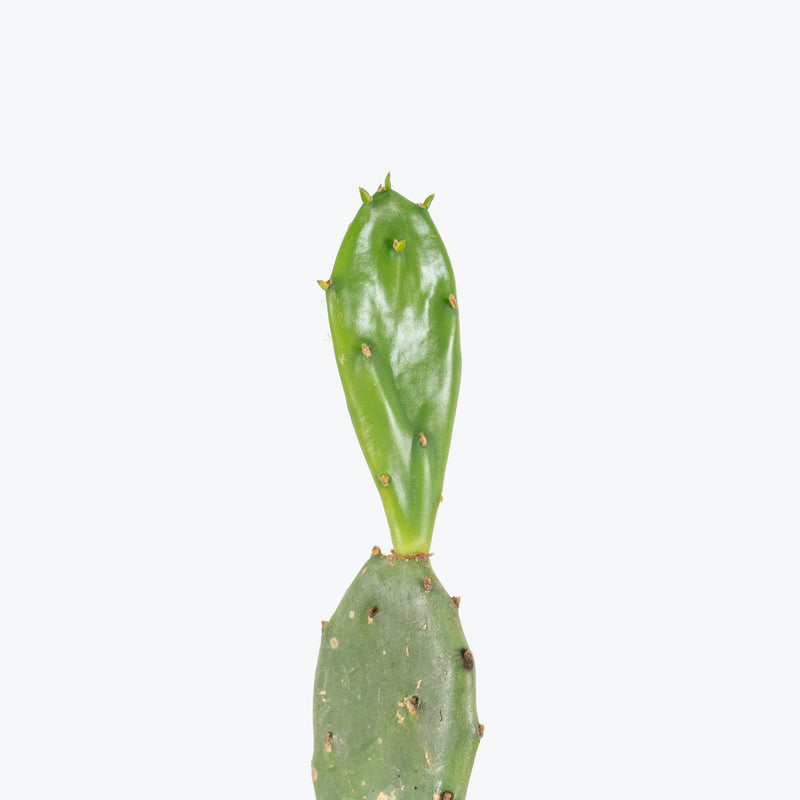
How to care for Eastern Prickly Pear Cactus
Eastern Prickly Pear Cactus loves as much sun as possible. The best spot for them is where they can see the sun during the majority of the day.
Eastern Prickly Pear Cactus will do best in bright light. A nice bright place inside your home would be on the window sill or a stool that is right next to a window, either with or without blinds, depending on if the plant can handle sun. Remember that plants will grow based on how much light they receive.
Eastern Prickly Pear Cactus likes the soil to be completely dry before the next watering. That can take about 4 weeks in an average home environment. It will vary depending on the time of year, your environment and lighting conditions, but for them, it's always safer to underwater or water when you see signs of lack of water (i.e. wrinkly or soft leaves). Water a little more often in the warmer months.
Their humidity requirement is low, so do not mist Eastern Prickly Pear Cactus or put them in a terrarium.
Eastern Prickly Pear Cactus will like a bright, warm spot in your home, but avoid watering them too much. Be cautious when handling your Prickly Pear Cactus due to its glochids and spines; it's advisable to use gloves or wrap the segments in newspaper to avoid getting pricked.
While the Eastern Prickly Pear Cactus is not toxic, its sharp spines can pose a physical hazard to pets and humans alike. It's advisable to place this plant in areas where contact with pets and children can be avoided to prevent injuries from its spines..
Learn MoreView PlantElephant Ear Staghorn Fern
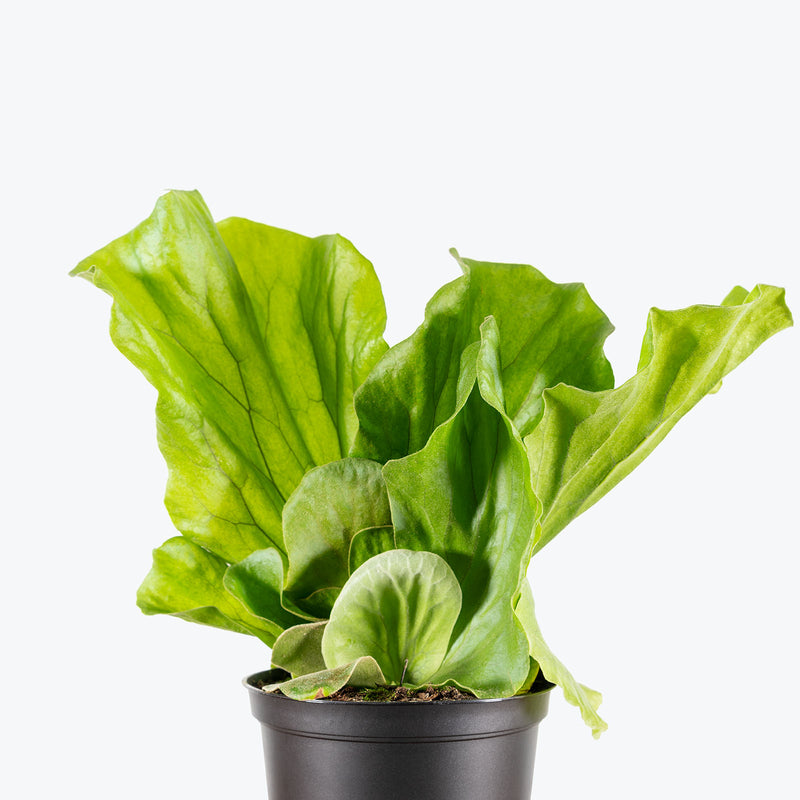
How to care for Elephant Ear Staghorn Fern
Elephant Ear Staghorn Fern should not be in a position to see the sun directly, although early morning or late evening sun is fine. Filtered sunlight through a sheer curtain is best and most homes are comprised primarily of indirect sunlight. The best spot for them is where they do not see the sun during the majority of the day but still get bright, indirect light.
Elephant Ear Staghorn Fern will do best in bright light. A nice bright place inside your home would be on the window sill or a stool that is right next to a window, either with or without blinds, depending on if the plant can handle sun. Remember that plants will grow based on how much light they receive.
Elephant Ear Staghorn Fern likes the soil to be relatively dry before the next watering. That usually takes about 2 weeks in an average home environment. It will vary depending on the time of year, your environment and lighting conditions, but for them, it's always safer to underwater or water when you see signs of lack of water (i.e. droopy, floppy, or soft leaves). Expect to water more often in brighter light and less often in lower light.
Elephant Ear Staghorn Fern likes a high humidity environment, give them a mist daily or as often as possible. Alternatively, you can put them around a humidifier. Although they won't die if they don't receive enough humidity, their leaves may have some dry, crunchy, or yellow edges.
Staghorn ferns have two types of fronds: shield fronds and bifurcated (forked) fronds. The former is located at the base of the plant and grow flatly, often appearing dried out or dead (don't fall in to the temptation of removing them). The bifurcated fronds are what the plant gets its common name from, as their forked appearance is reminiscent of deer antlers. Do not over-fertilize as this can harm the plant. Remove any dead or dying fronds to maintain plant health and aesthetics. If growing on a board or in a basket, ensure that the mounting material is secure and provides adequate support for the weight of the mature plant.
You can feel comfortable having Elephant Ear Staghorn Fern around your home in the potential case where your pet feels like nibbling on it. However, we typically recommend keeping your pets from eating any of your houseplants..
View PlantEllwoodii Cypress
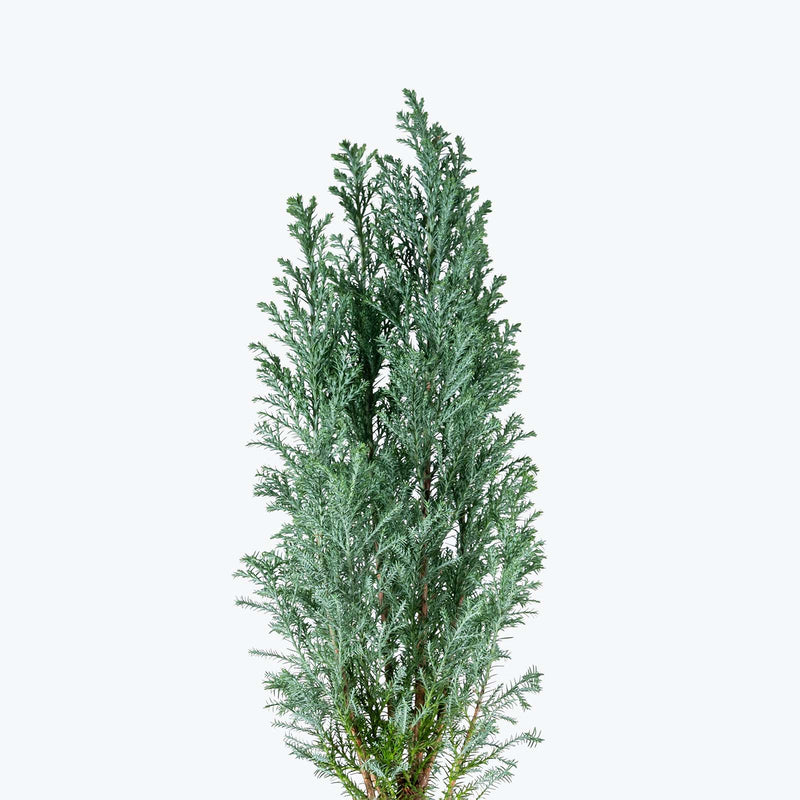
How to care for Ellwoodii Cypress
Ellwoodii Cypress enjoys some direct sun, but they'll also do well in bright, indirect light. It is best to place this plant somewhere where it will receive some nice morning sun, or a couple hours of afternoon sun, and then indirect light the rest of the day.
Ellwoodii Cypress will do best in bright light. A nice bright place inside your home would be on the window sill or a stool that is right next to a window, either with or without blinds, depending on if the plant can handle sun. Remember that plants will grow based on how much light they receive.
Ellwoodii Cypress needs to be watered when the top half of the soil is dry to the touch. That usually takes about 1 week in an average home environment. It will vary depending on the time of year, your environment and lighting conditions, but it's always safer to underwater or give the soil a check before you water again.
Ellwoodii Cypress can live in any average home humidity condition and are fairly hardy.
Use a well-draining potting mix and a container with good drainage. Avoid letting the root ball dry out completely. Fertilize lightly in spring with a slow-release, conifer-friendly fertilizer. If kept indoors long-term, rotate regularly for even growth. Outdoors, Ellwoodii Cypress grows best in cool to mild climates and benefits from protection from extreme heat.
Ellwoodii Cypress is moderately toxic and can cause some adverse reactions when ingested so it is best to not let your pets eat it, which we advise for all plants in general. The severity of the reaction will depend on how much of the plant is ingested but, if you know your pet typically does not eat your plants, this plant will be suitable for your home..
View PlantEmpire Cypress
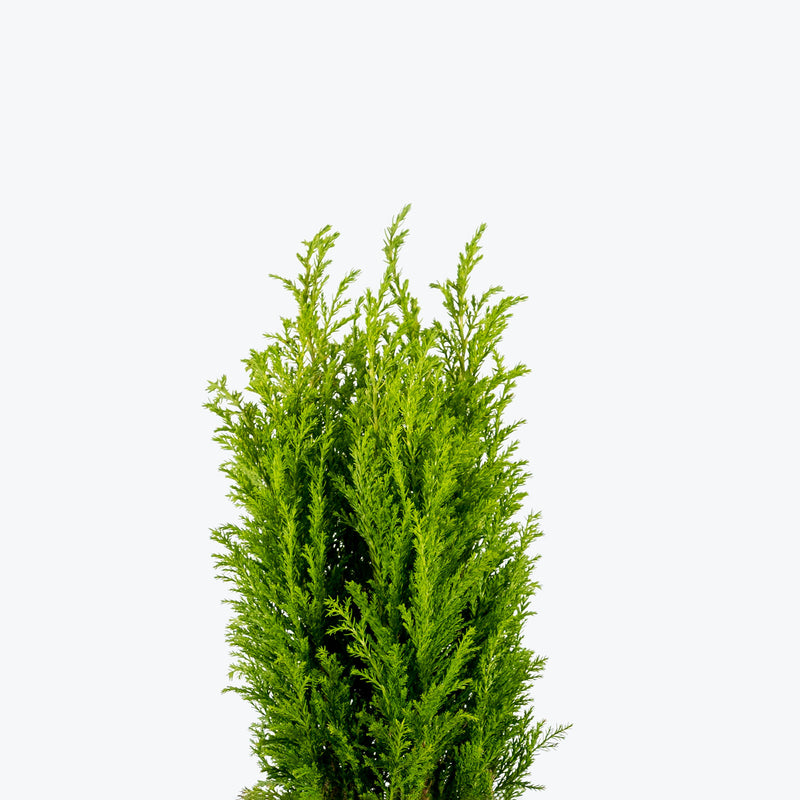
How to care for Empire Cypress
They enjoy some direct sun, but they'll also do well in bright, indirect light. It is best to place this plant somewhere where it will receive some nice morning sun, or a couple hours of afternoon sun, and then indirect light the rest of the day.
They will do best in bright light. A nice bright place inside your home would be on the window sill or a stool that is right next to a window, either with or without blinds, depending on if the plant can handle sun. Remember that plants will grow based on how much light they receive.
They need to be watered when the top half of the soil is dry to the touch. That usually takes about 1 week in an average home environment. It will vary depending on the time of year, your environment and lighting conditions, but it's always safer to underwater or give the soil a check before you water again.
They can live in any average home humidity condition and are fairly hardy.
Rotate the plant when watering to prevent it growing in one direction and becoming lopsided.
This plant is moderately toxic and can cause some adverse reactions when ingested so it is best to not let your pets eat it, which we advise for all plants in general. The severity of the reaction will depend on how much of the plant is ingested but, if you know your pet typically does not eat your plants, this plant will be suitable for your home..
View PlantEnglish Ivy
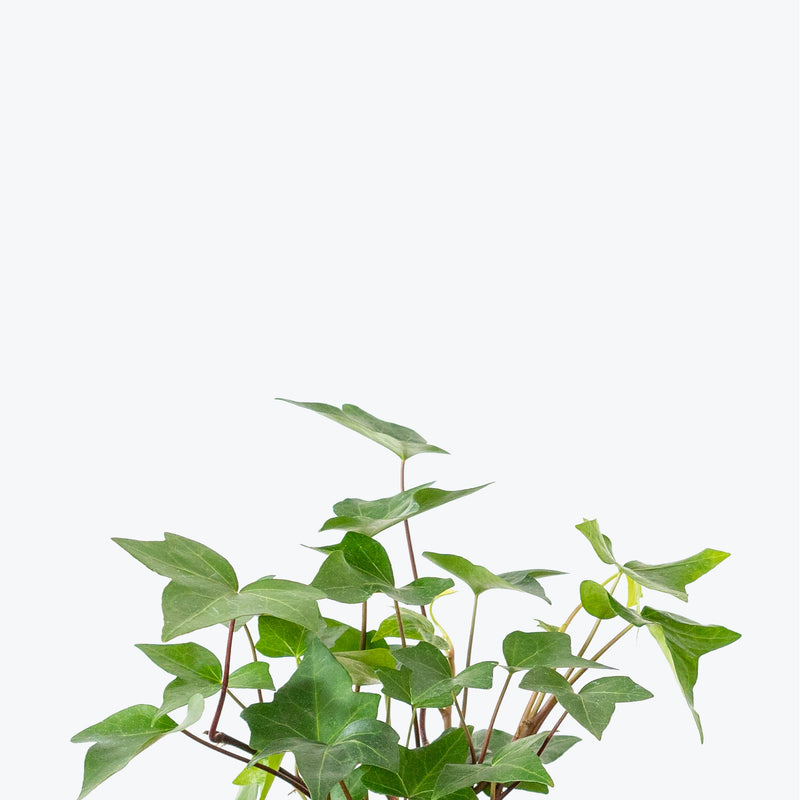
How to care for English Ivy
They should not be in a position to see the sun directly, although early morning or late evening sun is fine. Filtered sunlight through a sheer curtain is best and most homes are comprised primarily of indirect sunlight. The best spot for them is where they do not see the sun during the majority of the day but still get bright, indirect light.
They will do well in medium light but will grow faster with brighter light. A good medium-light place in your home would be in the middle of a room that has a regular size window. Remember that plants will grow based on how much light they receive.
They like the soil to be relatively dry before the next watering. That usually takes about 2 weeks in an average home environment. It will vary depending on the time of year, your environment and lighting conditions, but for them, it's always safer to underwater or water when you see signs of lack of water (i.e. droopy, floppy, or soft leaves). Water more often in the warmer months.
They will do well in average humidity environments but will appreciate a little bit of humidity if provided, give them a mist daily or get a humidifier.
Feel free to trim up long runners and repot them back into your plant to keep it looking bushy and full. Use sharp, clean scissors and carefully cut just below a leaf node, then remove the leaf at that node and plant that part of the stem, as that is where the roots will form.
This plant is moderately toxic and can cause some adverse reactions when ingested so it is best to not let your pets eat it, which we advise for all plants in general. The severity of the reaction will depend on how much of the plant is ingested but, if you know your pet typically does not eat your plants, this plant will be suitable for your home..
View PlantEnglish Ivy Variegated
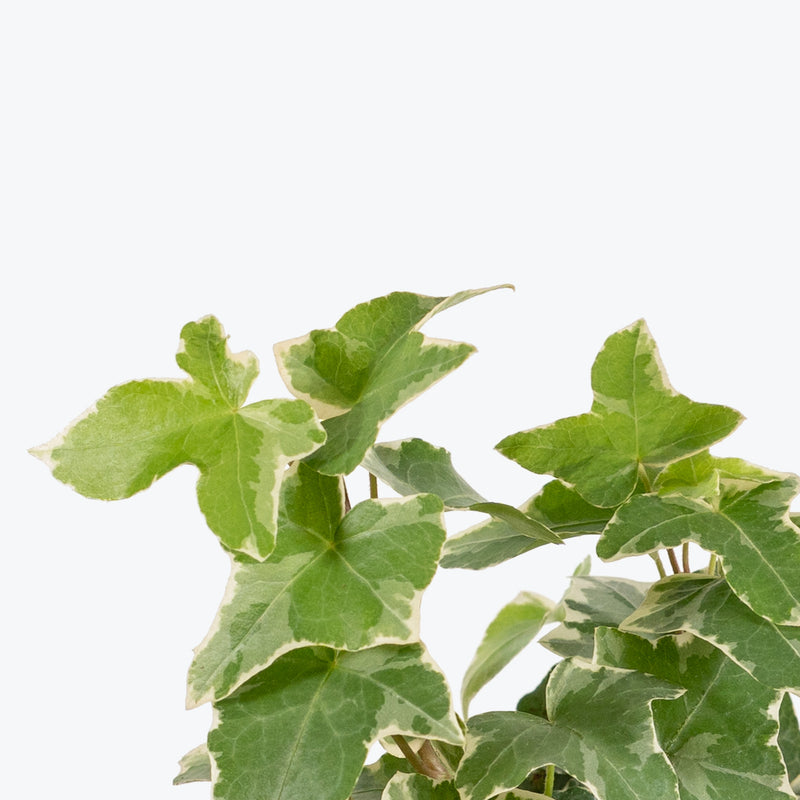
How to care for English Ivy Variegated
They should not be in a position to see the sun directly, although early morning or late evening sun is fine. Filtered sunlight through a sheer curtain is best and most homes are comprised primarily of indirect sunlight. The best spot for them is where they do not see the sun during the majority of the day but still get bright, indirect light.
They will do well in medium light but will grow faster with brighter light. A good medium-light place in your home would be in the middle of a room that has a regular size window. Remember that plants will grow based on how much light they receive.
They like the soil to be relatively dry before the next watering. That usually takes about 2 weeks in an average home environment. It will vary depending on the time of year, your environment and lighting conditions, but for them, it's always safer to underwater or water when you see signs of lack of water (i.e. droopy, floppy, or soft leaves). Water more often in the warmer months.
They will do well in average humidity environments but will appreciate a little bit of humidity if provided, give them a mist daily or get a humidifier.
Feel free to trim up long runners and repot them back into your plant to keep it looking bushy and full. Use sharp, clean scissors and carefully cut just below a leaf node, then remove the leaf at that node and plant that part of the stem, as that is where the roots will form.
This plant is moderately toxic and can cause some adverse reactions when ingested so it is best to not let your pets eat it, which we advise for all plants in general. The severity of the reaction will depend on how much of the plant is ingested but, if you know your pet typically does not eat your plants, this plant will be suitable for your home..
View PlantEpipremnum Amplissimum
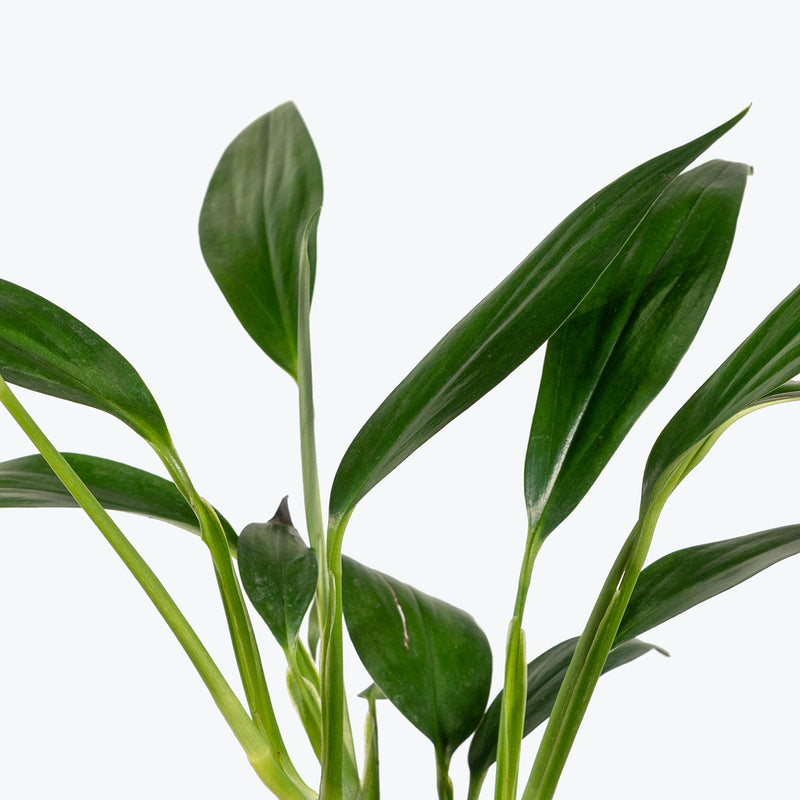
How to care for Epipremnum Amplissimum
Epipremnum Amplissimum should not be in a position to see the sun directly, although early morning or late evening sun is fine. Filtered sunlight through a sheer curtain is best and most homes are comprised primarily of indirect sunlight. The best spot for them is where they do not see the sun during the majority of the day but still get bright, indirect light.
Epipremnum Amplissimum will do well in medium light but will grow faster with brighter light. A good medium-light place in your home would be in the middle of a room that has a regular size window. Remember that plants will grow based on how much light they receive.
Epipremnum Amplissimum likes the soil to be relatively dry before the next watering. That usually takes about 2 weeks in an average home environment. It will vary depending on the time of year, your environment and lighting conditions, but for them, it's always safer to underwater or water when you see signs of lack of water (i.e. droopy, floppy, or soft leaves). Expect to water more often in brighter light and less often in lower light.
Epipremnum Amplissimum can live in any average home humidity condition and are fairly hardy.
Even though Epipremnum Amplissimum can tolerate lower light, if you want full, lush foliage, it would be better to keep your plant in a location with medium to bright, indirect light - your plant would greatly benefit from some morning sunlight. In order to encourage mature growth, over time, it would be ideal to grow your plant on a totem or moss pole to support its foliage.
Epipremnum Amplissimum is moderately toxic and can cause some adverse reactions when ingested so it is best to not let your pets eat it, which we advise for all plants in general. The severity of the reaction will depend on how much of the plant is ingested but, if you know your pet typically does not eat your plants, this plant will be suitable for your home..
View PlantEpipremnum Champs Élysées
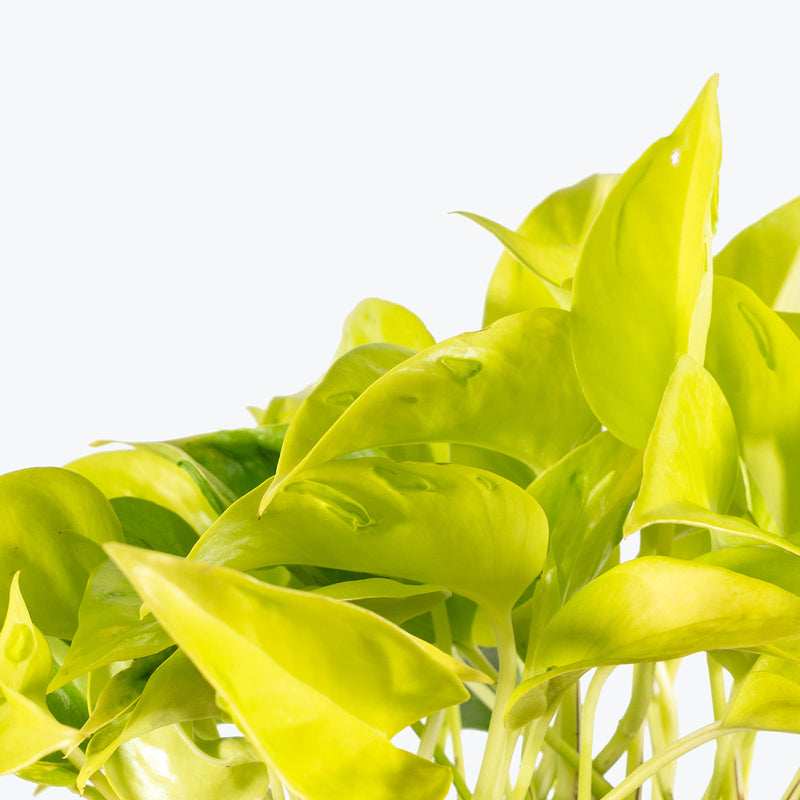
How to care for Epipremnum Champs Élysées
Epipremnum Champs Élysées should not be in a position to see the sun directly, although early morning or late evening sun is fine. Filtered sunlight through a sheer curtain is best and most homes are comprised primarily of indirect sunlight. The best spot for them is where they do not see the sun during the majority of the day but still get bright, indirect light.
Epipremnum Champs Élysées will thrive in medium to bright light, but also can tolerate low light. A good medium-light place in your home would be in the middle of a room that has a regular size window. They can be placed almost anywhere in the room but remember, plants will grow based on how much light they receive.
Epipremnum Champs Élysées likes the soil to be relatively dry before the next watering. That usually takes about 2 weeks in an average home environment. It will vary depending on the time of year, your environment and lighting conditions, but for them, it's always safer to underwater or water when you see signs of lack of water (i.e. droopy, floppy, or soft leaves). Expect to water more often in brighter light and less often in lower light.
Epipremnum Champs Élysées can live in any average home humidity condition and are fairly hardy.
Fertilize Epipremnum Champs Élysées with a balanced liquid houseplant fertilizer every two months during the growing season to support healthy growth and vibrant leaf colouration. Prune back any leggy vines to encourage fuller, bushier growth. Regularly check for common pests such as spider mites and treat as necessary.
Epipremnum Champs Élysées is moderately toxic and can cause some adverse reactions when ingested so it is best to not let your pets eat it, which we advise for all plants in general. The severity of the reaction will depend on how much of the plant is ingested but, if you know your pet typically does not eat your plants, this plant will be suitable for your home..
View PlantEpipremnum Giganteum Variegata
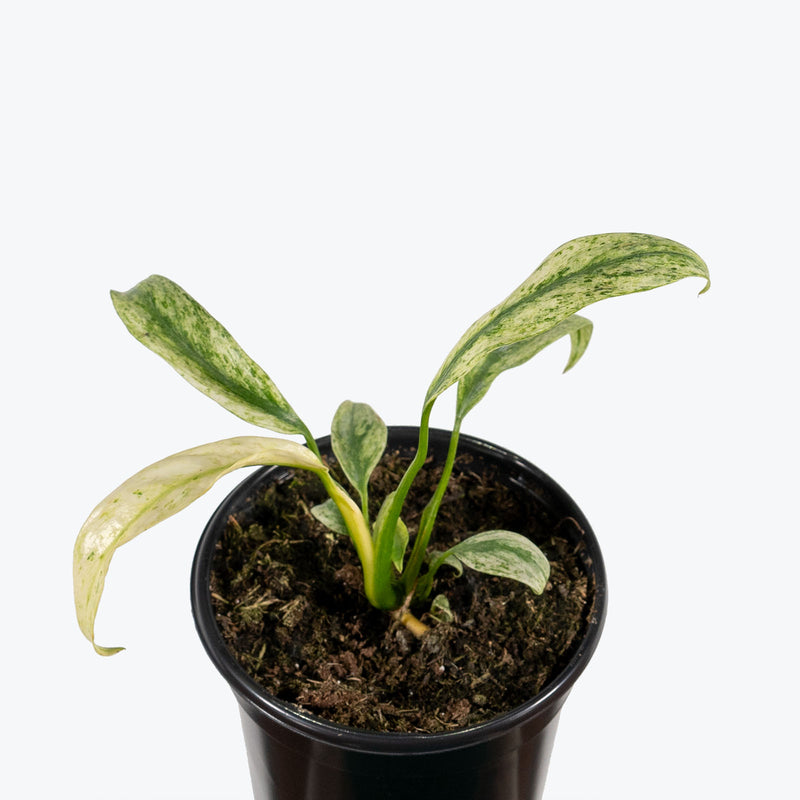
How to care for Epipremnum Giganteum Variegata
Epipremnum Giganteum Variegata should not be in a position to see the sun directly, although early morning or late evening sun is fine. Filtered sunlight through a sheer curtain is best and most homes are comprised primarily of indirect sunlight. The best spot for them is where they do not see the sun during the majority of the day but still get bright, indirect light.
Epipremnum Giganteum Variegata will do best in bright light. A nice bright place inside your home would be on the window sill or a stool that is right next to a window, either with or without blinds, depending on if the plant can handle sun. Remember that plants will grow based on how much light they receive.
Epipremnum Giganteum Variegata needs to be watered when the top half of the soil is dry to the touch. That usually takes about 1 week in an average home environment. It will vary depending on the time of year, your environment and lighting conditions, but it's always safer to underwater or give the soil a check before you water again. Expect to water more often in brighter light and less often in lower light.
Epipremnum Giganteum Variegata will do well in average humidity environments but will appreciate a little bit of humidity if provided, give them a mist daily or get a humidifier.
Regularly clean the Epipremnum Giganteum Variegata leaves with a damp cloth to remove dust and maintain the plant's health. Pruning can be done to control the plant's shape and encourage fuller growth. It's an excellent candidate for propagation through stem cuttings.
Epipremnum Giganteum Variegata is moderately toxic and can cause some adverse reactions when ingested so it is best to not let your pets eat it, which we advise for all plants in general. The severity of the reaction will depend on how much of the plant is ingested but, if you know your pet typically does not eat your plants, this plant will be suitable for your home..
View PlantEpipremnum Lemon Top
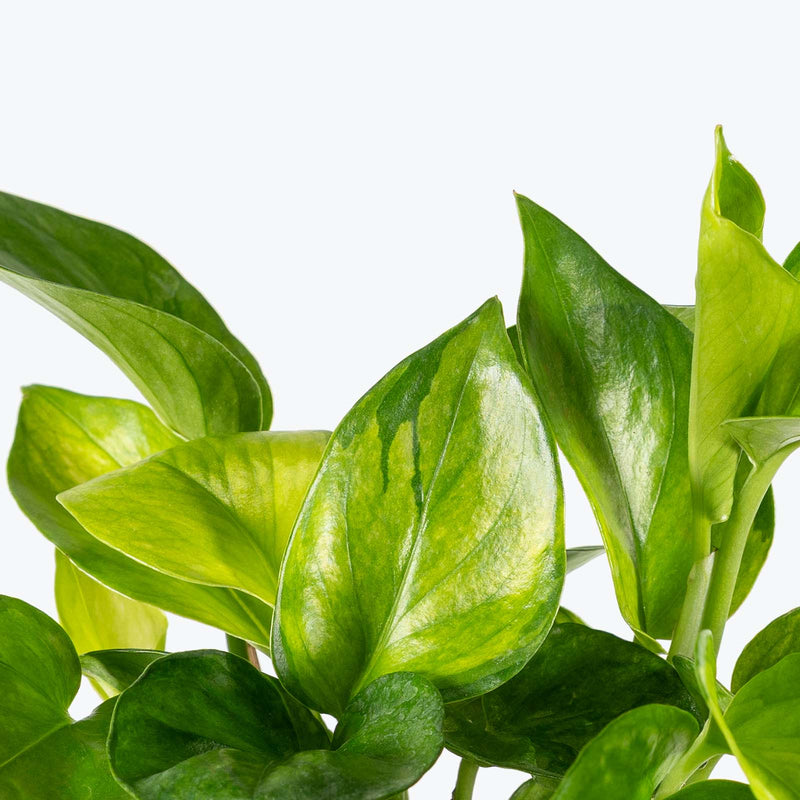
How to care for Epipremnum Lemon Top
Epipremnum Lemon Top should not be in a position to see the sun directly, although early morning or late evening sun is fine. Filtered sunlight through a sheer curtain is best and most homes are comprised primarily of indirect sunlight. The best spot for them is where they do not see the sun during the majority of the day but still get bright, indirect light.
Epipremnum Lemon Top will thrive in medium to bright light, but also can tolerate low light. A good medium-light place in your home would be in the middle of a room that has a regular size window. They can be placed almost anywhere in the room but remember, plants will grow based on how much light they receive.
Epipremnum Lemon Top likes the soil to be relatively dry before the next watering. That usually takes about 2 weeks in an average home environment. It will vary depending on the time of year, your environment and lighting conditions, but for them, it's always safer to underwater or water when you see signs of lack of water (i.e. droopy, floppy, or soft leaves). Expect to water more often in brighter light and less often in lower light.
Epipremnum Lemon Top can live in any average home humidity condition and are fairly hardy.
Epipremnum Lemon Top is known for being hardy and easy to care for, making it great for beginners. They can handle some neglect, so it's better to under-water than over-water. Although this plant can tolerate medium to low light, to maintain those large and beautifully variegated leaves, you will want to keep your plant in lots of bright, indirect light. Regularly trim back any excessively long vines to encourage fuller, bushier growth and to keep the plant looking tidy.
Epipremnum Lemon Top is moderately toxic and can cause some adverse reactions when ingested so it is best to not let your pets eat it, which we advise for all plants in general. The severity of the reaction will depend on how much of the plant is ingested but, if you know your pet typically does not eat your plants, this plant will be suitable for your home..
View PlantEpipremnum Pinnatum Albo
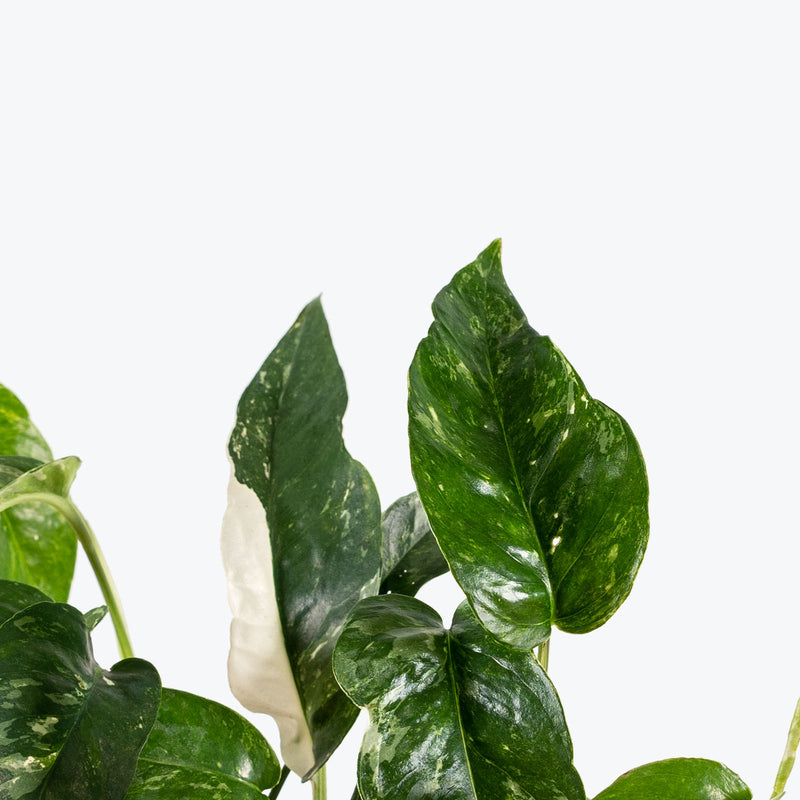
How to care for Epipremnum Pinnatum Albo
Epipremnum Pinnatum Albo should not be in a position to see the sun directly, although early morning or late evening sun is fine. Filtered sunlight through a sheer curtain is best and most homes are comprised primarily of indirect sunlight. The best spot for them is where they do not see the sun during the majority of the day but still get bright, indirect light.
Epipremnum Pinnatum Albo will do well in medium light but will grow faster with brighter light. A good medium-light place in your home would be in the middle of a room that has a regular size window. Remember that plants will grow based on how much light they receive.
Epipremnum Pinnatum Albo likes the soil to be relatively dry before the next watering. That usually takes about 2 weeks in an average home environment. It will vary depending on the time of year, your environment and lighting conditions, but for them, it's always safer to underwater or water when you see signs of lack of water (i.e. droopy, floppy, or soft leaves). Expect to water more often in brighter light and less often in lower light.
Epipremnum Pinnatum Albo can live in any average home humidity condition and are fairly hardy.
Even though Epipremnum Pinnatum Albo can tolerate lower light, if you want full, lush foliage, it would be better to keep your plant in a location with medium to bright, indirect light - your plant would greatly benefit from some morning sunlight. In order to encourage mature growth, over time, it would be ideal to grow your plant on a totem or moss pole to support its foliage.
Epipremnum Pinnatum Albo is moderately toxic and can cause some adverse reactions when ingested so it is best to not let your pets eat it, which we advise for all plants in general. The severity of the reaction will depend on how much of the plant is ingested but, if you know your pet typically does not eat your plants, this plant will be suitable for your home..
View PlantEpipremnum Pinnatum Marble

How to care for Epipremnum Pinnatum Marble
Epipremnum Pinnatum Marble should not be in a position to see the sun directly, although early morning or late evening sun is fine. Filtered sunlight through a sheer curtain is best and most homes are comprised primarily of indirect sunlight. The best spot for them is where they do not see the sun during the majority of the day but still get bright, indirect light.
Epipremnum Pinnatum Marble will do well in medium light but will grow faster with brighter light. A good medium-light place in your home would be in the middle of a room that has a regular size window. Remember that plants will grow based on how much light they receive.
Epipremnum Pinnatum Marble likes the soil to be relatively dry before the next watering. That usually takes about 2 weeks in an average home environment. It will vary depending on the time of year, your environment and lighting conditions, but for them, it's always safer to underwater or water when you see signs of lack of water (i.e. droopy, floppy, or soft leaves). Expect to water more often in brighter light and less often in lower light.
Epipremnum Pinnatum Marble can live in any average home humidity condition and are fairly hardy.
For bold variegation, give your Epipremnum Pinnatum Marble bright, indirect light — too little, and the creamy tones may fade. Train up a moss pole to encourage fenestrations as the plant matures. Prune regularly to control legginess and promote bushier growth. Use a chunky, well-draining potting mix with perlite and orchid bark for best results. Wipe leaves occasionally to remove dust and maintain shine.
Epipremnum Pinnatum Marble is moderately toxic and can cause some adverse reactions when ingested so it is best to not let your pets eat it, which we advise for all plants in general. The severity of the reaction will depend on how much of the plant is ingested but, if you know your pet typically does not eat your plants, this plant will be suitable for your home..
View PlantEpipremnum Pinnatum Neon
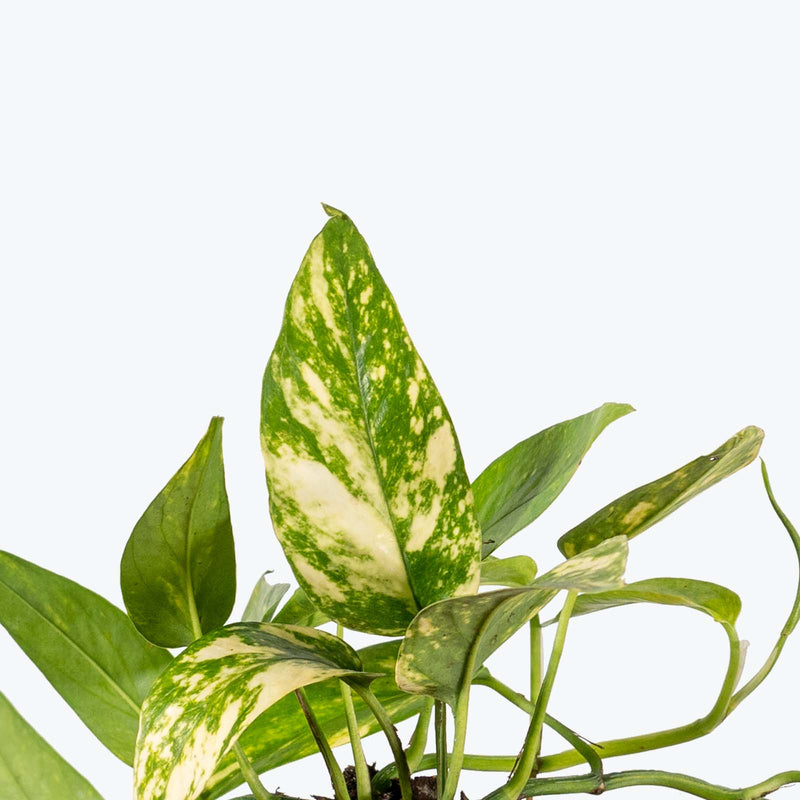
How to care for Epipremnum Pinnatum Neon
Epipremnum Pinnatum Neon should not be in a position to see the sun directly, although early morning or late evening sun is fine. Filtered sunlight through a sheer curtain is best and most homes are comprised primarily of indirect sunlight. The best spot for them is where they do not see the sun during the majority of the day but still get bright, indirect light.
Epipremnum Pinnatum Neon will do well in medium light but will grow faster with brighter light. A good medium-light place in your home would be in the middle of a room that has a regular size window. Remember that plants will grow based on how much light they receive.
Epipremnum Pinnatum Neon likes the soil to be relatively dry before the next watering. That usually takes about 2 weeks in an average home environment. It will vary depending on the time of year, your environment and lighting conditions, but for them, it's always safer to underwater or water when you see signs of lack of water (i.e. droopy, floppy, or soft leaves). Expect to water more often in brighter light and less often in lower light.
Epipremnum Pinnatum Neon can live in any average home humidity condition and are fairly hardy.
Even though Epipremnum Pinnatum Neon can tolerate lower light, for full, lush foliage, it's best to keep your plant in a location with medium to bright, indirect light. Morning sunlight would be beneficial. To encourage mature growth, consider growing your plant on a totem or moss pole to support its foliage.
Epipremnum Pinnatum Neon is moderately toxic and can cause some adverse reactions when ingested so it is best to not let your pets eat it, which we advise for all plants in general. The severity of the reaction will depend on how much of the plant is ingested but, if you know your pet typically does not eat your plants, this plant will be suitable for your home..
View PlantEpipremnum Pinnatum Skeleton Key
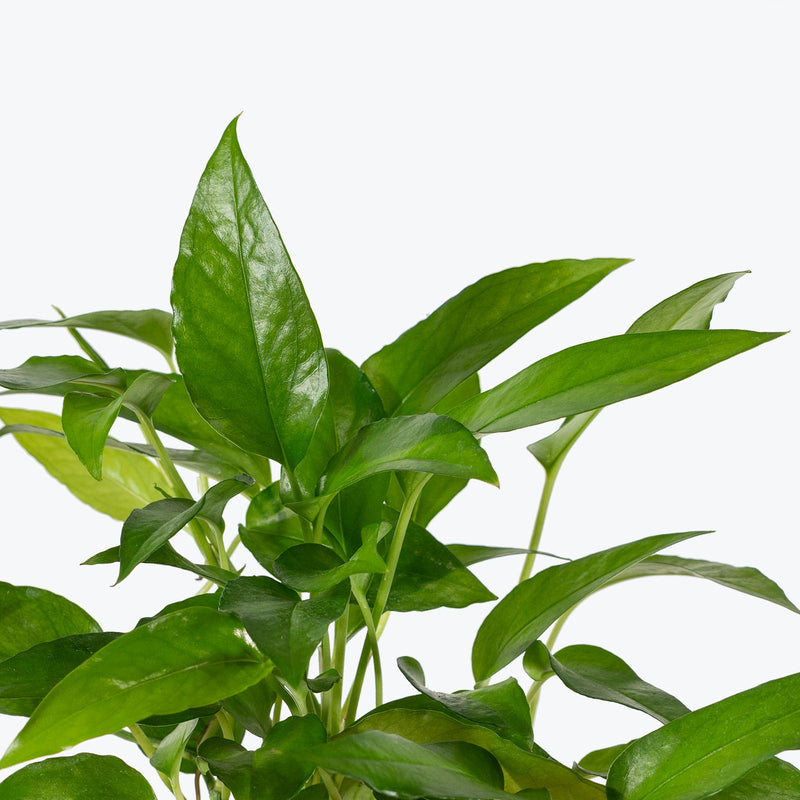
How to care for Epipremnum Pinnatum Skeleton Key
Epipremnum Pinnatum Skeleton Key should not be in a position to see the sun directly, although early morning or late evening sun is fine. Filtered sunlight through a sheer curtain is best and most homes are comprised primarily of indirect sunlight. The best spot for them is where they do not see the sun during the majority of the day but still get bright, indirect light.
Epipremnum Pinnatum Skeleton Key will do well in medium light but will grow faster with brighter light. A good medium-light place in your home would be in the middle of a room that has a regular size window. Remember that plants will grow based on how much light they receive.
Epipremnum Pinnatum Skeleton Key likes the soil to be relatively dry before the next watering. That usually takes about 2 weeks in an average home environment. It will vary depending on the time of year, your environment and lighting conditions, but for them, it's always safer to underwater or water when you see signs of lack of water (i.e. droopy, floppy, or soft leaves). Expect to water more often in brighter light and less often in lower light.
Epipremnum Pinnatum Skeleton Key can live in any average home humidity condition and are fairly hardy.
Support the climbing habit of the Epipremnum Pinnatum Skeleton Key with a moss pole or trellis to encourage vertical growth. Regularly clean the leaves to keep them dust-free and healthy. Fertilize every 4-6 weeks during the growing season with a diluted, balanced fertilizer.
Epipremnum Pinnatum Skeleton Key is moderately toxic and can cause some adverse reactions when ingested so it is best to not let your pets eat it, which we advise for all plants in general. The severity of the reaction will depend on how much of the plant is ingested but, if you know your pet typically does not eat your plants, this plant will be suitable for your home..
View PlantEpipremnum Shangri La
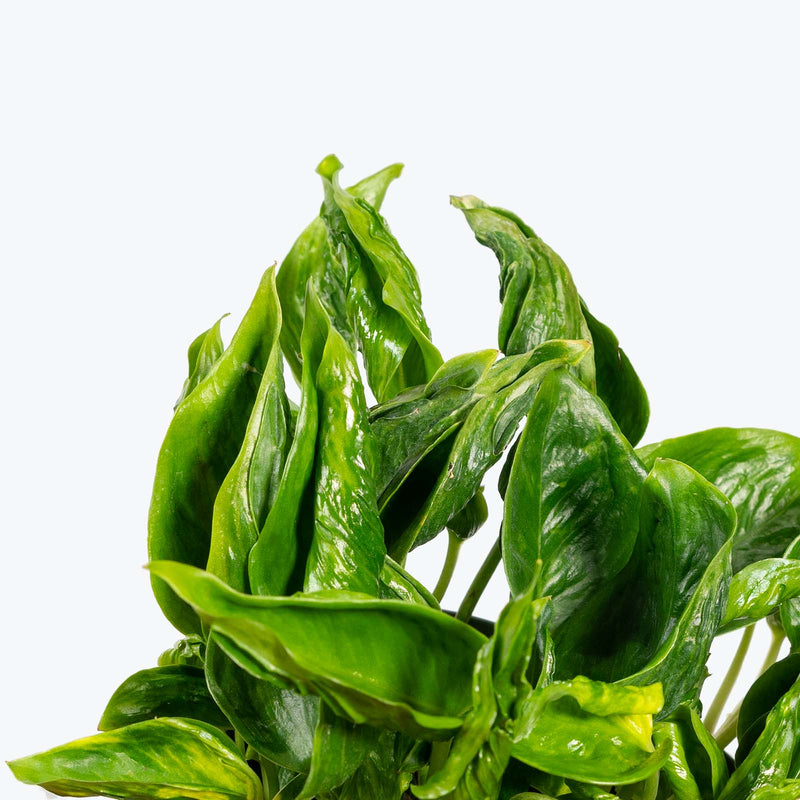
How to care for Epipremnum Shangri La
Epipremnum Shangri La should not be in a position to see the sun directly, although early morning or late evening sun is fine. Filtered sunlight through a sheer curtain is best and most homes are comprised primarily of indirect sunlight. The best spot for them is where they do not see the sun during the majority of the day but still get bright, indirect light.
Epipremnum Shangri La will thrive in medium to bright light, but also can tolerate low light. A good medium-light place in your home would be in the middle of a room that has a regular size window. They can be placed almost anywhere in the room but remember, plants will grow based on how much light they receive.
Epipremnum Shangri La likes the soil to be relatively dry before the next watering. That usually takes about 2 weeks in an average home environment. It will vary depending on the time of year, your environment and lighting conditions, but for them, it's always safer to underwater or water when you see signs of lack of water (i.e. droopy, floppy, or soft leaves). Expect to water more often in brighter light and less often in lower light.
Epipremnum Shangri La can live in any average home humidity condition and are fairly hardy.
Since the Shangri La pothos variety has some variegation in the leaves, it will need brighter light to support that variegation, so keep that in mind if it is placed in lower light. Feel free to trim your Pothos regularly as this encourages the plant to develop more side-shoots and reduces the demand for the plant to develop a larger root system while confined. Their cuttings propagate very easily in water.
Epipremnum Shangri La is moderately toxic and can cause some adverse reactions when ingested so it is best to not let your pets eat it, which we advise for all plants in general. The severity of the reaction will depend on how much of the plant is ingested but, if you know your pet typically does not eat your plants, this plant will be suitable for your home..
View PlantEpiscia Chocolate Soldier
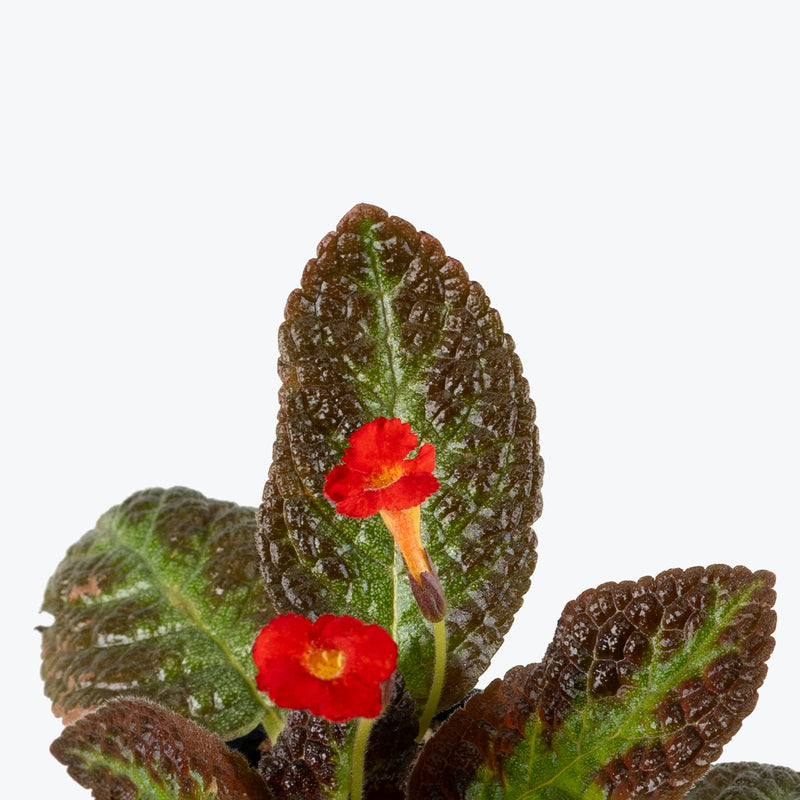
How to care for Episcia Chocolate Soldier
Episcia Chocolate Soldier should not be in a position to see the sun directly, although early morning or late evening sun is fine. Filtered sunlight through a sheer curtain is best and most homes are comprised primarily of indirect sunlight. The best spot for them is where they do not see the sun during the majority of the day but still get bright, indirect light.
Episcia Chocolate Soldier will thrive in bright light, but also can tolerate medium light. A good medium-light place in your home would be in the middle of a room that has a regular size window. They can be placed anywhere between the middle of the room and the window. Remember that plants will grow based on how much light they receive.
Episcia Chocolate Soldier needs to be watered when the top half of the soil is dry to the touch. That usually takes about 1 week in an average home environment. It will vary depending on the time of year, your environment and lighting conditions, but it's always safer to underwater or give the soil a check before you water again.
Episcia Chocolate Soldier will do well in average humidity environments but will appreciate a little bit of humidity if provided! Avoid misting the leaves though as this can lead to powdery mildew.
The velvety leaves of Episcia Chocolate Soldier do not take well to misting or much contact with water, especially cold water. Instead, provide humidity with a pebble tray or a humidifier in the area, and water with lukewarm water. Be cautious with fertilization; excessive feeding can lead to salt buildup in the soil. Regularly prune the plant to maintain its shape and promote denser growth. Remove any yellow or dead leaves to keep the plant healthy and attractive. Clean the leaves occasionally to remove dust and enhance the plant's aesthetic.
You can feel comfortable having Episcia Chocolate Soldier around your home in the potential case where your pet feels like nibbling on it. However, we typically recommend keeping your pets from eating any of your houseplants..
View PlantEpiscia Cupreata Copper
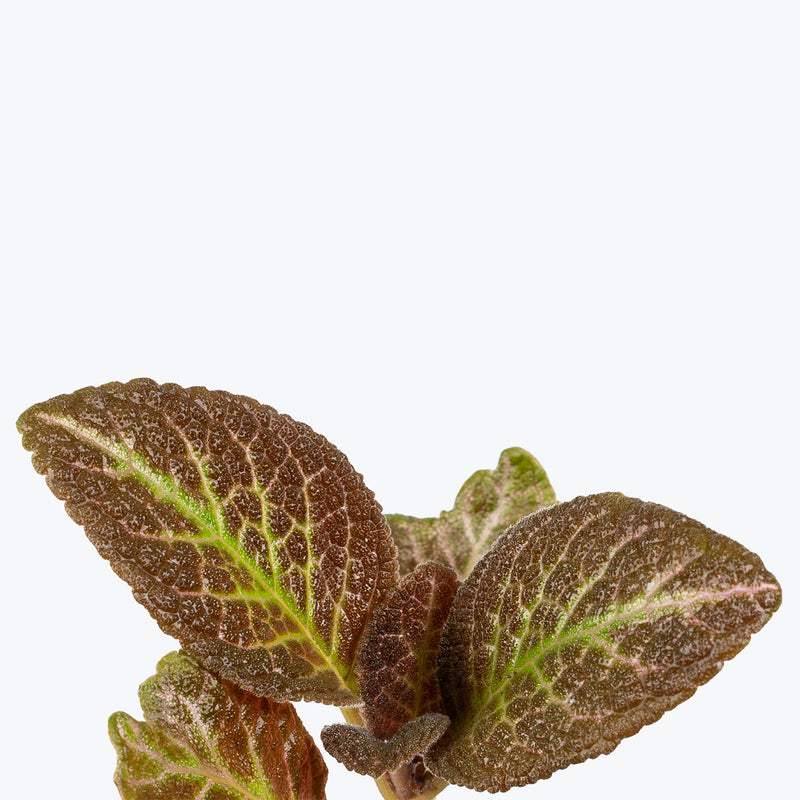
How to care for Episcia Cupreata Copper
Episcia Cupreata Copper should not be in a position to see the sun directly, although early morning or late evening sun is fine. Filtered sunlight through a sheer curtain is best and most homes are comprised primarily of indirect sunlight. The best spot for them is where they do not see the sun during the majority of the day but still get bright, indirect light.
Episcia Cupreata Copper will thrive in bright light, but also can tolerate medium light. A good medium-light place in your home would be in the middle of a room that has a regular size window. They can be placed anywhere between the middle of the room and the window. Remember that plants will grow based on how much light they receive.
Episcia Cupreata Copper needs to be watered when the top half of the soil is dry to the touch. That usually takes about 1 week in an average home environment. It will vary depending on the time of year, your environment and lighting conditions, but it's always safer to underwater or give the soil a check before you water again.
Episcia Cupreata Copper will do well in average humidity environments but will appreciate a little bit of humidity if provided! Avoid misting the leaves though as this can lead to powdery mildew.
The velvety leaves of Episcia Cupreata Copper do not take well to misting or much contact with water, especially cold water. Instead, provide humidity with a pebble tray or a humidifier in the area, and water with lukewarm water. Use a light, airy soil mix similar to that for African violets. Feed monthly during spring and summer with a diluted, balanced fertilizer to encourage lush growth and continuous flowering. Pinch back stems to maintain shape and promote fuller growth. Keep away from cold drafts and dry air.
You can feel comfortable having Episcia Cupreata Copper around your home in the potential case where your pet feels like nibbling on it. However, we typically recommend keeping your pets from eating any of your houseplants..
View PlantEpiscia Faded Jade
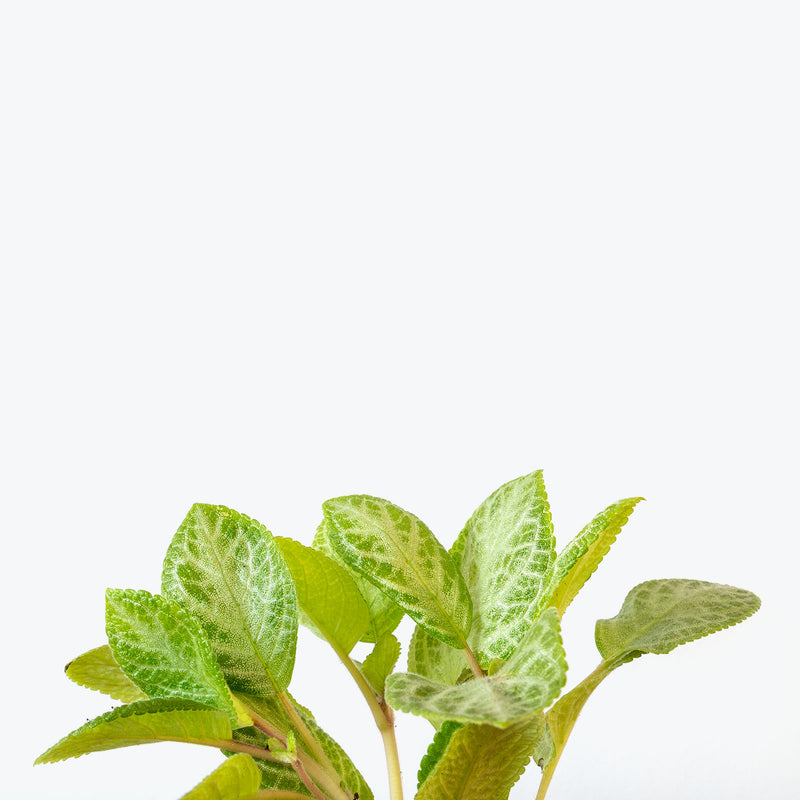
How to care for Episcia Faded Jade
They should not be in a position to see the sun directly, although early morning or late evening sun is fine. Filtered sunlight through a sheer curtain is best and most homes are comprised primarily of indirect sunlight. The best spot for them is where they do not see the sun during the majority of the day but still get bright, indirect light.
They will thrive in bright light, but also can tolerate medium light. A good medium-light place in your home would be in the middle of a room that has a regular size window. They can be placed anywhere between the middle of the room and the window. Remember that plants will grow based on how much light they receive.
They need to be watered when the top half of the soil is dry to the touch. That usually takes about 1 week in an average home environment. It will vary depending on the time of year, your environment and lighting conditions, but it's always safer to underwater or give the soil a check before you water again.
They will do well in average humidity environments but will appreciate a little bit of humidity if provided! Avoid misting the leaves though as this can lead to powdery mildew.
The velvety leaves of Episcia houseplants do not take well to misting or many contacts with water, especially cold water. Instead, provide humidity with a pebble tray or a humidifier in the area, and water with lukewarm water.
You can feel comfortable having this plant around your home in the potential case where your pet feels like nibbling on it. However, we typically recommend keeping your pets from eating any of your houseplants..
View PlantEpiscia Lil Lemon
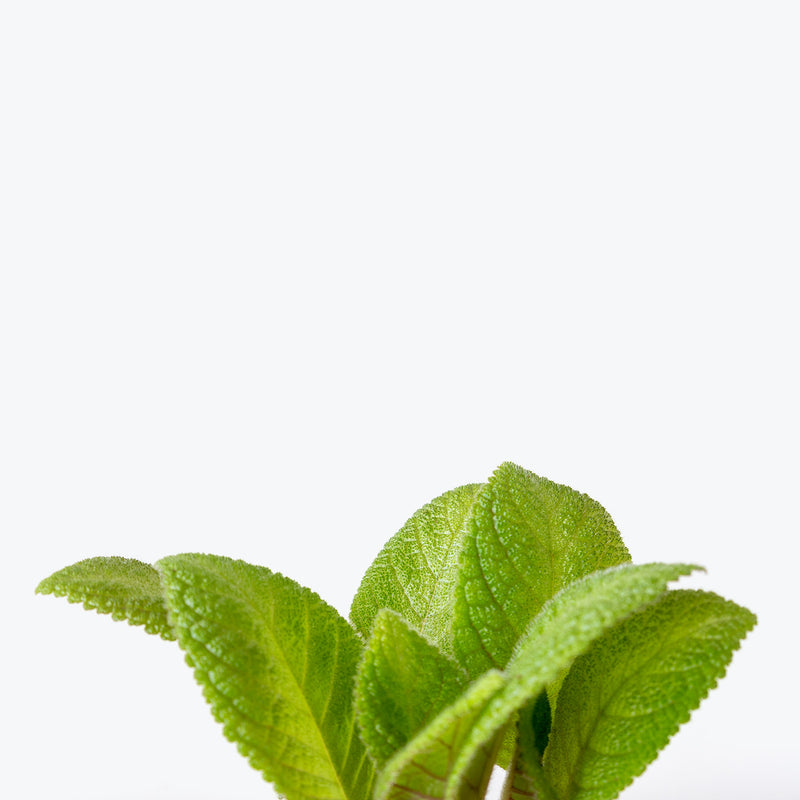
How to care for Episcia Lil Lemon
They should not be in a position to see the sun directly, although early morning or late evening sun is fine. Filtered sunlight through a sheer curtain is best and most homes are comprised primarily of indirect sunlight. The best spot for them is where they do not see the sun during the majority of the day but still get bright, indirect light.
They will thrive in bright light, but also can tolerate medium light. A good medium-light place in your home would be in the middle of a room that has a regular size window. They can be placed anywhere between the middle of the room and the window. Remember that plants will grow based on how much light they receive.
They need to be watered when the top half of the soil is dry to the touch. That usually takes about 1 week in an average home environment. It will vary depending on the time of year, your environment and lighting conditions, but it's always safer to underwater or give the soil a check before you water again.
They will do well in average humidity environments but will appreciate a little bit of humidity if provided! Avoid misting the leaves though as this can lead to powdery mildew.
The velvety leaves of Episcia houseplants do not take well to misting or much contact with water, especially cold water. Instead, provide humidity with a pebble tray or a humidifier in the area, and water with lukewarm water.
You can feel comfortable having this plant around your home in the potential case where your pet feels like nibbling on it. However, we typically recommend keeping your pets from eating any of your houseplants..
View PlantEpiscia Pink Brocade
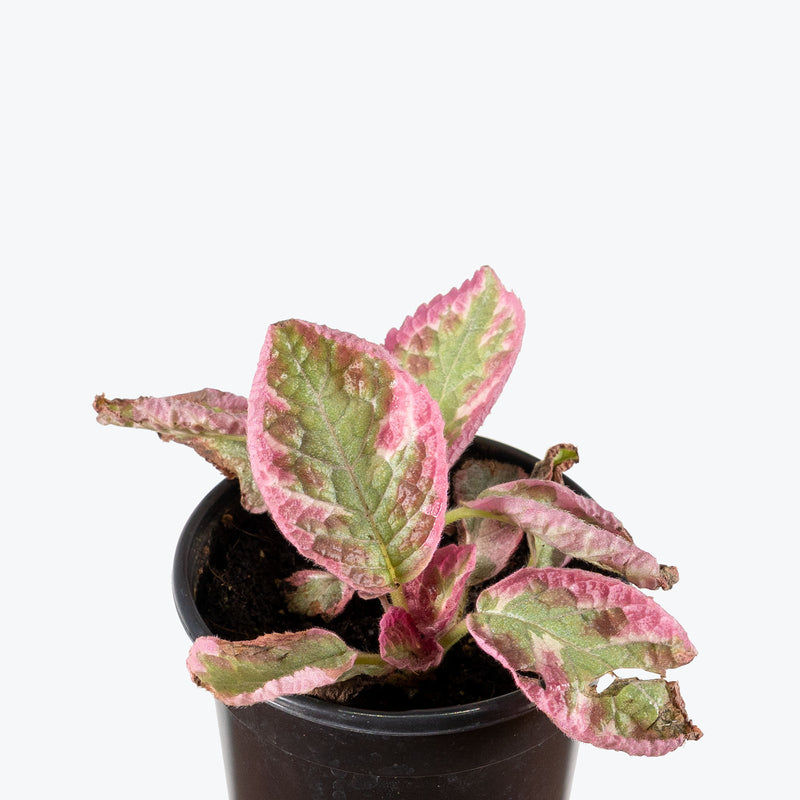
How to care for Episcia Pink Brocade
Episcia Pink Brocade should not be in a position to see the sun directly, although early morning or late evening sun is fine. Filtered sunlight through a sheer curtain is best and most homes are comprised primarily of indirect sunlight. The best spot for them is where they do not see the sun during the majority of the day but still get bright, indirect light.
Episcia Pink Brocade will thrive in bright light, but also can tolerate medium light. A good medium-light place in your home would be in the middle of a room that has a regular size window. They can be placed anywhere between the middle of the room and the window. Remember that plants will grow based on how much light they receive.
Episcia Pink Brocade needs to be watered when the top half of the soil is dry to the touch. That usually takes about 1 week in an average home environment. It will vary depending on the time of year, your environment and lighting conditions, but it's always safer to underwater or give the soil a check before you water again.
Episcia Pink Brocade will do well in average humidity environments but will appreciate a little bit of humidity if provided! Avoid misting the leaves though as this can lead to powdery mildew.
Episcia Pink Brocade prefers warmth and consistent moisture — keep away from cold drafts and never let the soil go completely dry. Use a peat-based mix with good drainage and avoid overhead watering to protect the fuzzy leaves, they do not take well to misting or many contacts with water, especially cold water. Bright light brings out the strongest variegation. Trim runners if you prefer a tidy look, or let them sprawl and root for a fuller display. Fertilize every 2–3 weeks during spring and summer to encourage vibrant blooms.
You can feel comfortable having Episcia Pink Brocade around your home in the potential case where your pet feels like nibbling on it. However, we typically recommend keeping your pets from eating any of your houseplants..
View PlantEpiscia Purple Rain

How to care for Episcia Purple Rain
Episcia Purple Rain should not be in a position to see the sun directly, although early morning or late evening sun is fine. Filtered sunlight through a sheer curtain is best and most homes are comprised primarily of indirect sunlight. The best spot for them is where they do not see the sun during the majority of the day but still get bright, indirect light.
Episcia Purple Rain will thrive in bright light, but also can tolerate medium light. A good medium-light place in your home would be in the middle of a room that has a regular size window. They can be placed anywhere between the middle of the room and the window. Remember that plants will grow based on how much light they receive.
Episcia Purple Rain needs to be watered when the top half of the soil is dry to the touch. That usually takes about 1 week in an average home environment. It will vary depending on the time of year, your environment and lighting conditions, but it's always safer to underwater or give the soil a check before you water again.
Episcia Purple Rain will do well in average humidity environments but will appreciate a little bit of humidity if provided! Avoid misting the leaves though as this can lead to powdery mildew.
The velvety leaves of Episcia Purple Rain do not take well to misting or much contact with water, especially cold water. Instead, provide humidity with a pebble tray or a humidifier in the area, and water with lukewarm water. Be cautious with fertilization; excessive feeding can lead to salt buildup in the soil. Regularly prune the plant to maintain its shape and promote denser growth. Remove any yellow or dead leaves to keep the plant healthy and attractive. Clean the leaves occasionally to remove dust and enhance the plant's aesthetic.
You can feel comfortable having Episcia Purple Rain around your home in the potential case where your pet feels like nibbling on it. However, we typically recommend keeping your pets from eating any of your houseplants..
View PlantEpiscia Sea Foam
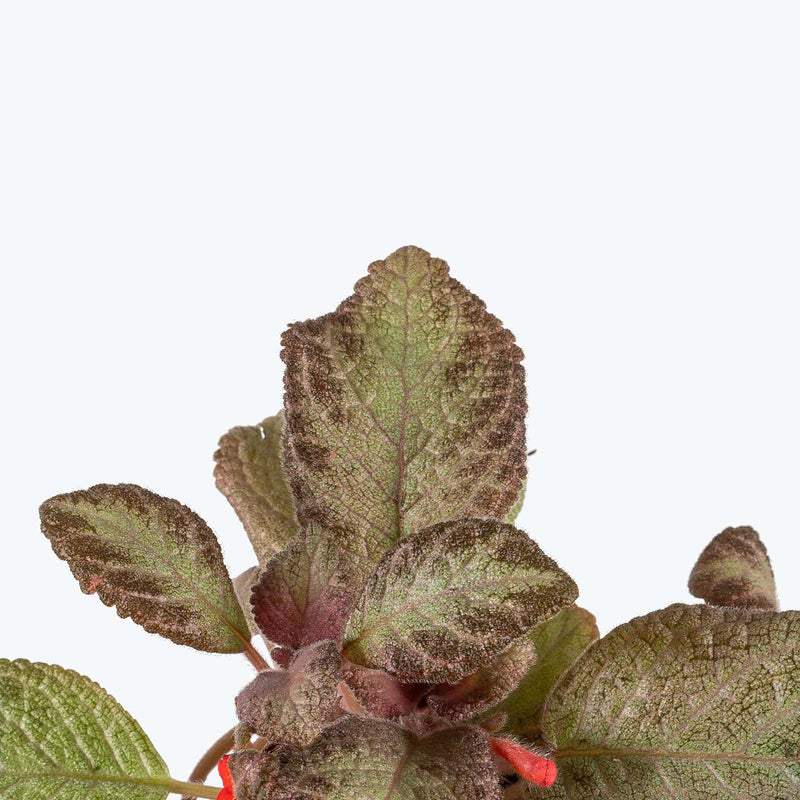
How to care for Episcia Sea Foam
Episcia Sea Foam should not be in a position to see the sun directly, although early morning or late evening sun is fine. Filtered sunlight through a sheer curtain is best and most homes are comprised primarily of indirect sunlight. The best spot for them is where they do not see the sun during the majority of the day but still get bright, indirect light.
Episcia Sea Foam will thrive in bright light, but also can tolerate medium light. A good medium-light place in your home would be in the middle of a room that has a regular size window. They can be placed anywhere between the middle of the room and the window. Remember that plants will grow based on how much light they receive.
Episcia Sea Foam needs to be watered when the top half of the soil is dry to the touch. That usually takes about 1 week in an average home environment. It will vary depending on the time of year, your environment and lighting conditions, but it's always safer to underwater or give the soil a check before you water again.
Episcia Sea Foam will do well in average humidity environments but will appreciate a little bit of humidity if provided! Avoid misting the leaves though as this can lead to powdery mildew.
Use a lightweight, airy soil mix. Pinch off spent blooms to encourage continuous flowering. Avoid getting water on the leaves to prevent spotting. Episcia Sea Foam enjoys warmth, so keep away from cold drafts and temperature dips.
You can feel comfortable having Episcia Sea Foam around your home in the potential case where your pet feels like nibbling on it. However, we typically recommend keeping your pets from eating any of your houseplants..
View PlantEpiscia Silver Sheen
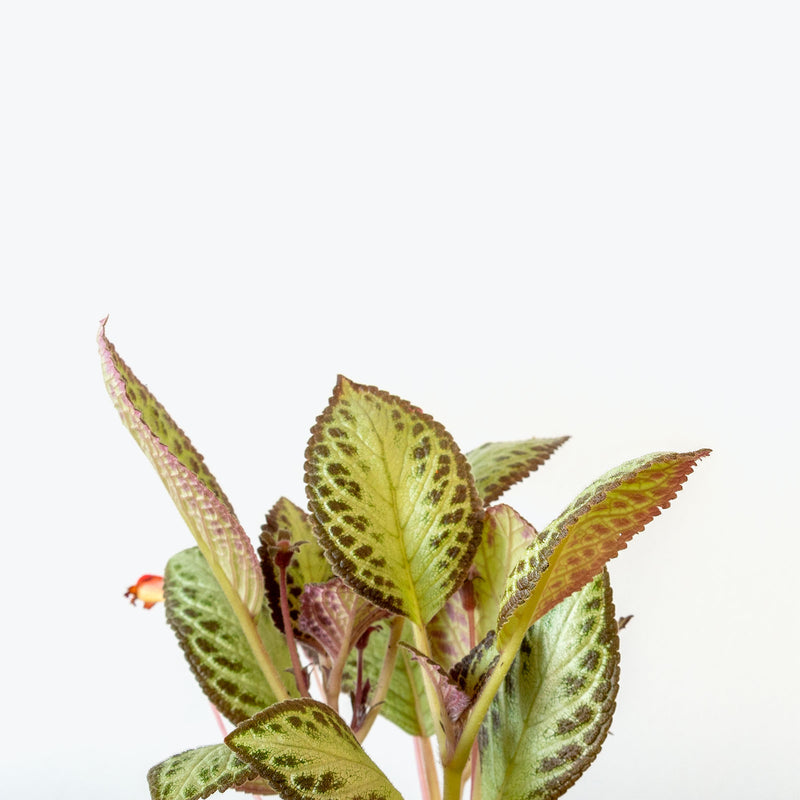
How to care for Episcia Silver Sheen
Episcia Silver Sheen should not be in a position to see the sun directly, although early morning or late evening sun is fine. Filtered sunlight through a sheer curtain is best and most homes are comprised primarily of indirect sunlight. The best spot for them is where they do not see the sun during the majority of the day but still get bright, indirect light.
Episcia Silver Sheen will thrive in bright light, but also can tolerate medium light. A good medium-light place in your home would be in the middle of a room that has a regular size window. They can be placed anywhere between the middle of the room and the window. Remember that plants will grow based on how much light they receive.
Episcia Silver Sheen needs to be watered when the top half of the soil is dry to the touch. That usually takes about 1 week in an average home environment. It will vary depending on the time of year, your environment and lighting conditions, but it's always safer to underwater or give the soil a check before you water again.
Episcia Silver Sheen will do well in average humidity environments but will appreciate a little bit of humidity if provided! Avoid misting the leaves though as this can lead to powdery mildew.
The velvety leaves of Episcia Silver Sheen do not take well to misting or much contact with water, especially cold water. Instead, provide humidity with a pebble tray or a humidifier in the area, and water with lukewarm water. Pinch back the tips of the stems regularly to encourage a bushier growth and prevent the plant from becoming too leggy. Clean the leaves occasionally to remove dust and enhance the plant's aesthetic.
You can feel comfortable having Episcia Silver Sheen around your home in the potential case where your pet feels like nibbling on it. However, we typically recommend keeping your pets from eating any of your houseplants..
View PlantEpiscia Strawberry Patch
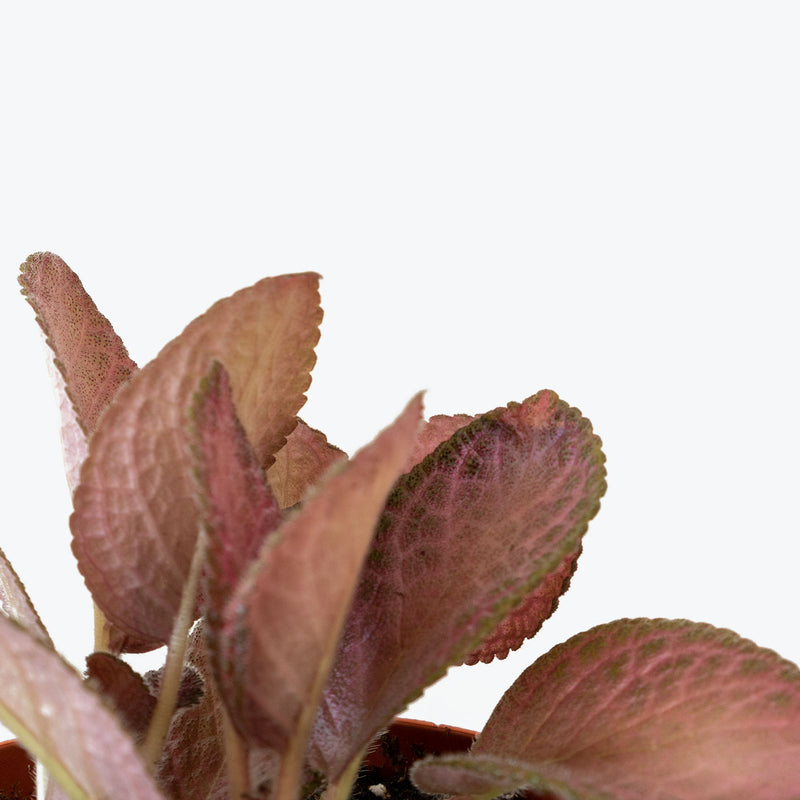
How to care for Episcia Strawberry Patch
They should not be in a position to see the sun directly, although early morning or late evening sun is fine. Filtered sunlight through a sheer curtain is best and most homes are comprised primarily of indirect sunlight. The best spot for them is where they do not see the sun during the majority of the day but still get bright, indirect light.
They will thrive in bright light, but also can tolerate medium light. A good medium-light place in your home would be in the middle of a room that has a regular size window. They can be placed anywhere between the middle of the room and the window. Remember that plants will grow based on how much light they receive.
They need to be watered when the top half of the soil is dry to the touch. That usually takes about 1 week in an average home environment. It will vary depending on the time of year, your environment and lighting conditions, but it's always safer to underwater or give the soil a check before you water again.
They will do well in average humidity environments but will appreciate a little bit of humidity if provided! Avoid misting the leaves though as this can lead to powdery mildew.
The velvety leaves of Episcia houseplants do not take well to misting or much contact with water, especially cold water. Instead, provide humidity with a pebble tray or a humidifier in the area, and water with lukewarm water.
You can feel comfortable having this plant around your home in the potential case where your pet feels like nibbling on it. However, we typically recommend keeping your pets from eating any of your houseplants..
View PlantEucalyptus
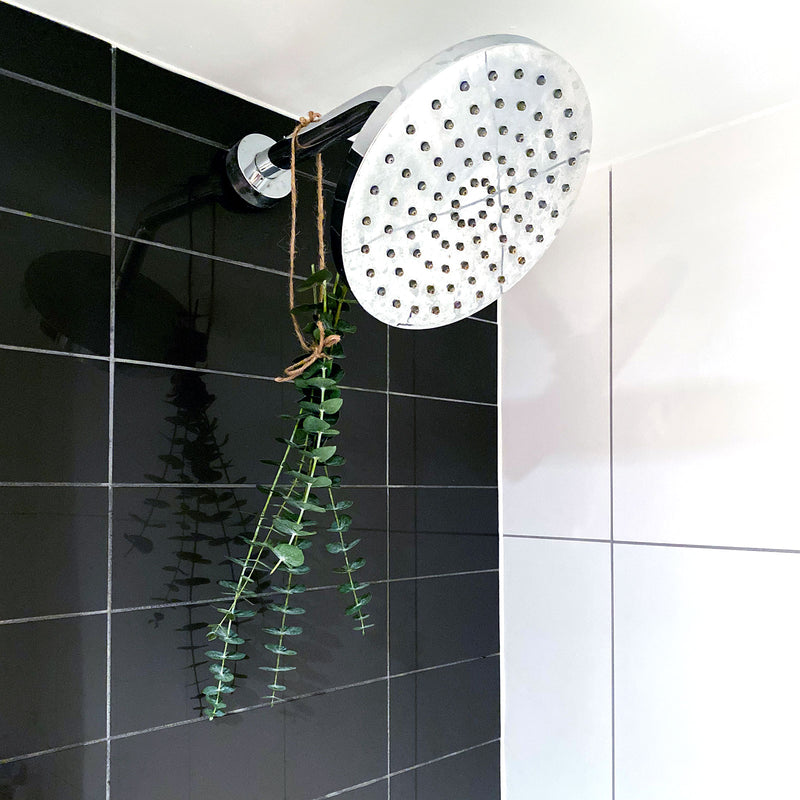
How to care for Eucalyptus
This plant is moderately toxic and can cause some adverse reactions when ingested so it is best to not let your pets eat it, which we advise for all plants in general. The severity of the reaction will depend on how much of the plant is ingested but, if you know your pet typically does not eat your plants, this plant will be suitable for your home..
View PlantEucalyptus Plant
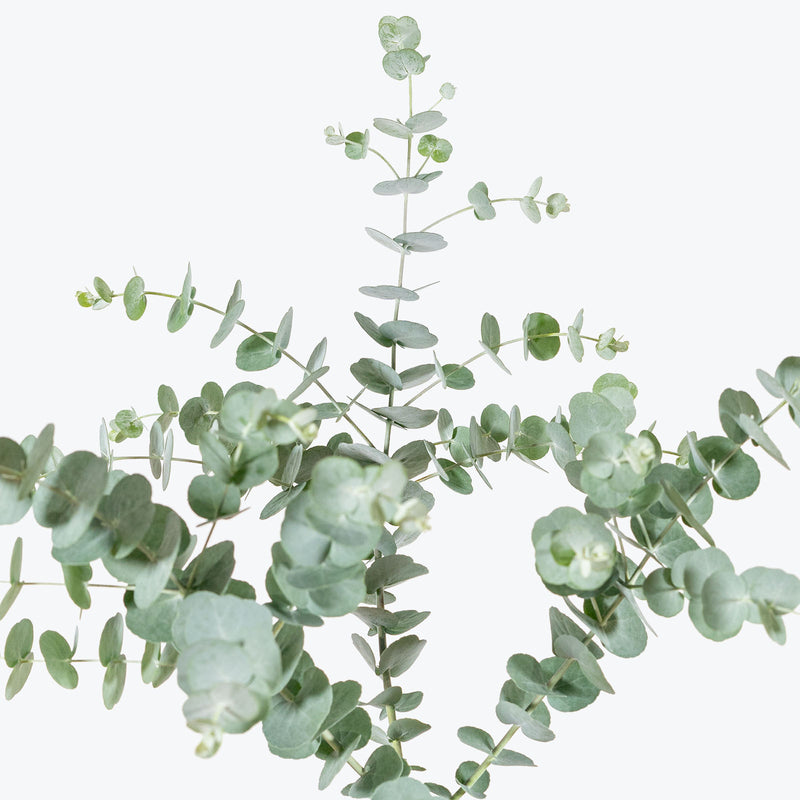
How to care for Eucalyptus Plant
Eucalyptus Plant loves as much sun as possible. The best spot for them is where they can see the sun during the majority of the day.
Eucalyptus Plant will do their best and flower profusely in bright light. A nice bright place outside would be on a sunny balcony, deck, or backyard; inside your home, it would do best in a sunny window sill. Remember that plants will grow and flower based on how much light they receive.
Eucalyptus Plant needs to be watered when the top half of the soil is dry to the touch. That usually takes about 1 week in an average home environment. It will vary depending on the time of year, your environment and lighting conditions, but it's always safer to underwater or give the soil a check before you water again. Expect to water more often in brighter light and less often in lower light.
Eucalyptus Plant will do well in average humidity environments but will appreciate a little bit of humidity if provided, give them a mist daily or get a humidifier.
Since potted eucalyptus plants grow fairly quickly, they often need a bit of pruning and repotting. You can nip the ends off of your plant if it’s getting too unruly, or you can add a stake in and help it grow up while it’s still small. You should do any major pruning in the spring when your plant can rebound quickly. Protect from frost, as 'Baby Blue' can be sensitive to extreme cold.
Eucalyptus Plant is moderately toxic and can cause some adverse reactions when ingested so it is best to not let your pets eat it, which we advise for all plants in general. The severity of the reaction will depend on how much of the plant is ingested but, if you know your pet typically does not eat your plants, this plant will be suitable for your home..
View PlantEuphorbia Acrurensis
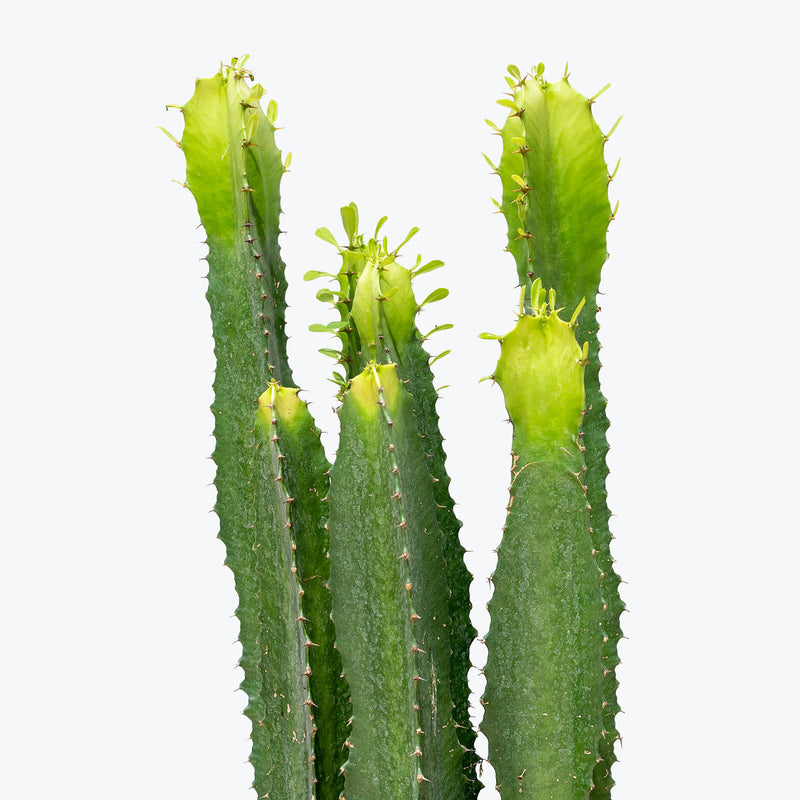
How to care for Euphorbia Acrurensis
They enjoy some direct sun, but they'll also do well in bright, indirect light. It is best to place this plant somewhere where it will receive some nice morning sun, or a couple hours of afternoon sun, and then indirect light the rest of the day.
They will thrive in bright light, but also can tolerate medium light. A good medium-light place in your home would be in the middle of a room that has a regular size window. They can be placed anywhere between the middle of the room and the window. Remember that plants will grow based on how much light they receive.
They like the soil to be completely dry before the next watering. That usually takes about 4 weeks in an average home environment. It will vary depending on the time of year, your environment and lighting conditions, but for them, it's always safer to underwater or water when you see signs of lack of water (i.e. wrinkly or soft leaves). Water a little more often in the warmer months.
Their humidity requirement is low, so do not mist them or put them in an enclosed terrarium.
They are drought-tolerant and prefer to be under-watered, especially during the cooler months. Not sure when to water? Wrinkles on the leaves are a telltale sign. Keep them in a very warm location as well.
This plant is moderately toxic and can cause some adverse reactions when ingested so it is best to not let your pets eat it, which we advise for all plants in general. The severity of the reaction will depend on how much of the plant is ingested but, if you know your pet typically does not eat your plants, this plant will be suitable for your home..
View PlantEuphorbia Acrurensis Variegata

How to care for Euphorbia Acrurensis Variegata
They enjoy some direct sun, but they'll also do well in bright, indirect light. It is best to place this plant somewhere where it will receive some nice morning sun, or a couple hours of afternoon sun, and then indirect light the rest of the day.
They will thrive in bright light, but also can tolerate medium light. A good medium-light place in your home would be in the middle of a room that has a regular size window. They can be placed anywhere between the middle of the room and the window. Remember that plants will grow based on how much light they receive.
They like the soil to be completely dry before the next watering. That usually takes about 4 weeks in an average home environment. It will vary depending on the time of year, your environment and lighting conditions, but for them, it's always safer to underwater or water when you see signs of lack of water (i.e. wrinkly or soft leaves). Water a little more often in the warmer months.
Their humidity requirement is low, so do not mist them or put them in an enclosed terrarium.
They are drought-tolerant and prefer to be under-watered, especially during the cooler months. Not sure when to water? Wrinkles on the leaves are a telltale sign. Keep them in a very warm location a well.
This plant is moderately toxic and can cause some adverse reactions when ingested so it is best to not let your pets eat it, which we advise for all plants in general. The severity of the reaction will depend on how much of the plant is ingested but, if you know your pet typically does not eat your plants, this plant will be suitable for your home..
View PlantEuphorbia Ammak Variegata
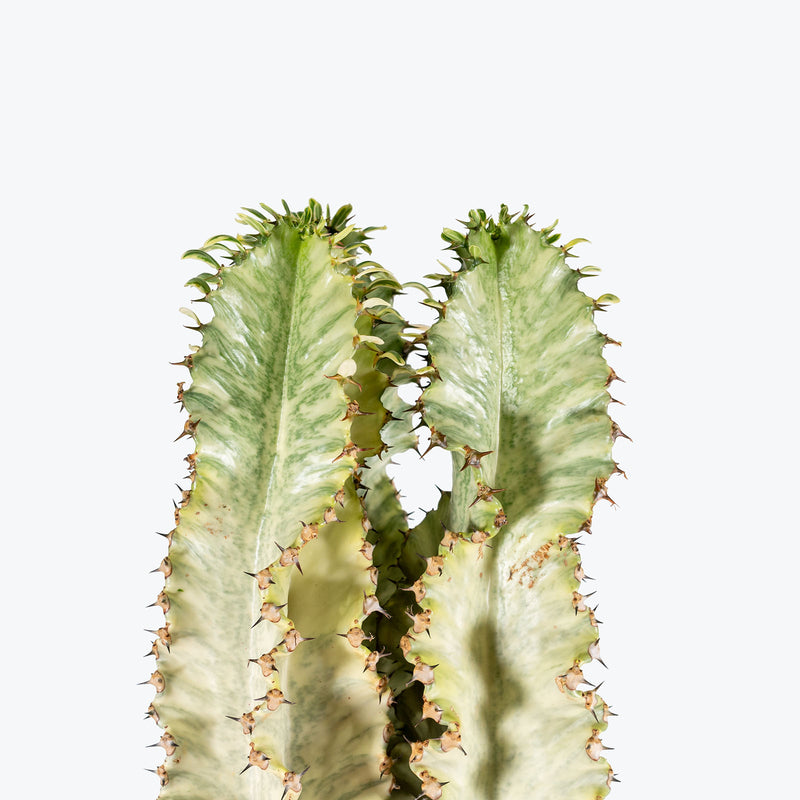
How to care for Euphorbia Ammak Variegata
Euphorbia Ammak Variegata enjoys some direct sun, but they'll also do well in bright, indirect light. It is best to place this plant somewhere where it will receive some nice morning sun, or a couple hours of afternoon sun, and then indirect light the rest of the day.
Euphorbia Ammak Variegata will do best in bright light. A nice bright place inside your home would be on the window sill or a stool that is right next to a window, either with or without blinds, depending on if the plant can handle sun. Remember that plants will grow based on how much light they receive.
Euphorbia Ammak Variegata likes the soil to be completely dry before the next watering. That usually takes about 4 weeks in an average home environment. It will vary depending on the time of year, your environment and lighting conditions, but for them, it's always safer to underwater or water when you see signs of lack of water (i.e. wrinkly or soft leaves). Water a little more often in the warmer months.
Their humidity requirement is low, so do not mist Euphorbia Ammak Variegata or put them in an enclosed terrarium.
Use a well-draining soil mix formulated for cacti and succulents to prevent root rot. Fertilize sparingly, using a low-nitrogen cactus fertilizer once during the spring to encourage growth without compromising the plant's structural integrity. Due to Euphorbia Ammak Variegata's potential size and weight, ensure that containers are stable and robust.
Euphorbia Ammak Variegata is moderately toxic and can cause some adverse reactions when ingested so it is best to not let your pets eat it, which we advise for all plants in general. The severity of the reaction will depend on how much of the plant is ingested but, if you know your pet typically does not eat your plants, this plant will be suitable for your home..
View PlantEuphorbia Decaryi

How to care for Euphorbia Decaryi
They enjoy some direct sun, but they'll also do well in bright, indirect light. It is best to place this plant somewhere where it will receive some nice morning sun, or a couple hours of afternoon sun, and then indirect light the rest of the day.
They will do best in bright light. A nice bright place inside your home would be on the window sill or a stool that is right next to a window, either with or without blinds, depending on if the plant can handle sun. Remember that plants will grow based on how much light they receive.
They like the soil to be completely dry before the next watering. This can take up to 4 weeks in an average home environment but it will vary depending on the time of year, your environment and lighting conditions. For them, it's always safer to underwater or water when you see signs of lack of water (i.e. wrinkly or soft leaves). Water a little more often in the warmer months.
Their humidity requirement is low, so do not mist them or put them in a terrarium.
They will typically flower at some point indoors so be prepared for the daintiest, yellow-green or red flowers at some point. If your plant is kept in very bright light, it may need to be watered a little more frequently to support its growth throughout the spring and summer months.
This plant is moderately toxic and can cause some adverse reactions when ingested so it is best to not let your pets eat it, which we advise for all plants in general. The severity of the reaction will depend on how much of the plant is ingested but, if you know your pet typically does not eat your plants, this plant will be suitable for your home..
View PlantEuphorbia Ferox

How to care for Euphorbia Ferox
They enjoy some direct sun, but they'll also do well in bright, indirect light. It is best to place this plant somewhere where it will receive some nice morning sun, or a couple hours of afternoon sun, and then indirect light the rest of the day.
They will thrive in bright light, but also can tolerate medium light. A good medium-light place in your home would be in the middle of a room that has a regular size window. They can be placed anywhere between the middle of the room and the window. Remember that plants will grow based on how much light they receive.
They like the soil to be completely dry before the next watering. This can take up to 4 weeks in an average home environment but it will vary depending on the time of year, your environment and lighting conditions. For them, it's always safer to underwater or water when you see signs of lack of water (i.e. wrinkly or soft leaves). Water a little more often in the warmer months.
Their humidity requirement is low, so do not mist them or put them in a terrarium.
They are drought-tolerant and prefer to be under-watered, especially during the cooler months. Not sure when to water? Wrinkles on the leaves are a telltale sign. Keep them in a very warm location as well.
This plant is moderately toxic and can cause some adverse reactions when ingested so it is best to not let your pets eat it, which we advise for all plants in general. The severity of the reaction will depend on how much of the plant is ingested but, if you know your pet typically does not eat your plants, this plant will be suitable for your home..
View PlantEuphorbia Lactea

How to care for Euphorbia Lactea
Euphorbia Lactea enjoys some direct sun, but they'll also do well in bright, indirect light. It is best to place this plant somewhere where it will receive some nice morning sun, or a couple hours of afternoon sun, and then indirect light the rest of the day.
Euphorbia Lactea will thrive in bright light, but also can tolerate medium light. A good medium-light place in your home would be in the middle of a room that has a regular size window. They can be placed anywhere between the middle of the room and the window. Remember that plants will grow based on how much light they receive.
Euphorbia Lactea likes the soil to be completely dry before the next watering. That usually takes about 4 weeks in an average home environment. It will vary depending on the time of year, your environment and lighting conditions, but for them, it's always safer to underwater or water when you see signs of lack of water (i.e. wrinkly or soft leaves). Water a little more often in the warmer months.
Their humidity requirement is low, so do not mist Euphorbia Lactea or put them in an enclosed terrarium.
Handle Euphorbia Lactea with care as the plant's milky sap can cause skin and eye irritation and is toxic if ingested. Keep it away from children and pets. Also, it's a good practice to provide it with a winter rest period at cooler temperatures and with reduced watering.
Euphorbia Lactea is moderately toxic and can cause some adverse reactions when ingested so it is best to not let your pets eat it, which we advise for all plants in general. The severity of the reaction will depend on how much of the plant is ingested but, if you know your pet typically does not eat your plants, this plant will be suitable for your home..
View PlantEuphorbia Lactea Red Tip

How to care for Euphorbia Lactea Red Tip
Euphorbia Lactea enjoys some direct sun, but they'll also do well in bright, indirect light. It is best to place this plant somewhere where it will receive some nice morning sun, or a couple hours of afternoon sun, and then indirect light the rest of the day.
Euphorbia Lactea will thrive in bright light, but also can tolerate medium light. A good medium-light place in your home would be in the middle of a room that has a regular size window. They can be placed anywhere between the middle of the room and the window. Remember that plants will grow based on how much light they receive.
Euphorbia Lactea likes the soil to be completely dry before the next watering. That usually takes about 4 weeks in an average home environment. It will vary depending on the time of year, your environment and lighting conditions, but for them, it's always safer to underwater or water when you see signs of lack of water (i.e. wrinkly or soft leaves). Water a little more often in the warmer months.
Their humidity requirement is low, so do not mist Euphorbia Lactea or put them in an enclosed terrarium.
Handle Euphorbia Lactea with care as the plant's milky sap can cause skin and eye irritation and is toxic if ingested. Keep it away from children and pets. Also, it's a good practice to provide it with a winter rest period at cooler temperatures and with reduced watering.
Euphorbia Lactea is moderately toxic and can cause some adverse reactions when ingested so it is best to not let your pets eat it, which we advise for all plants in general. The severity of the reaction will depend on how much of the plant is ingested but, if you know your pet typically does not eat your plants, this plant will be suitable for your home..
View PlantEuphorbia Lactea White Ghost
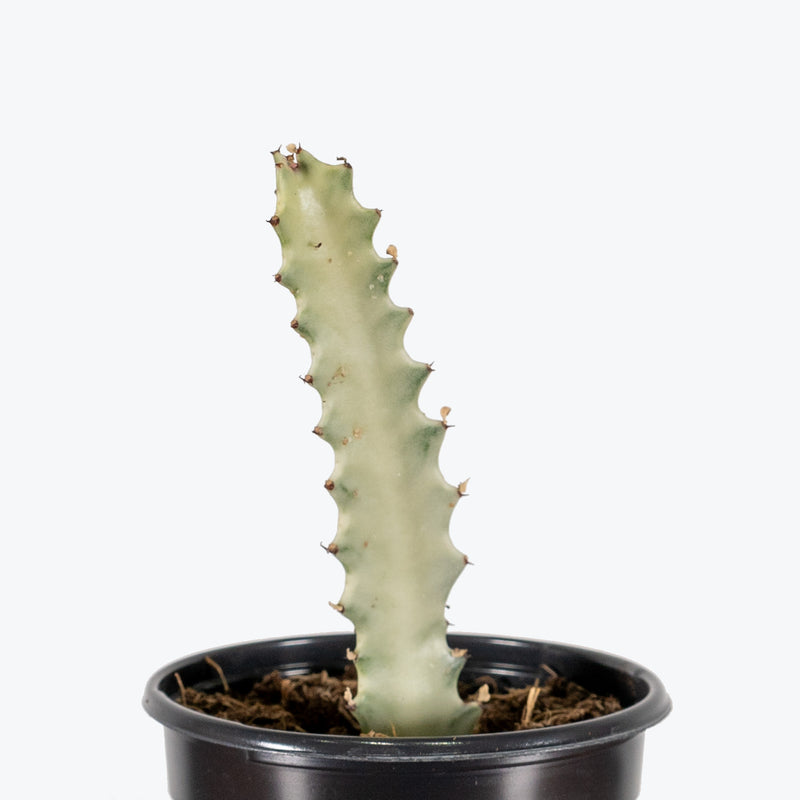
How to care for Euphorbia Lactea White Ghost
Euphorbia Lactea White Ghost enjoys some direct sun, but they'll also do well in bright, indirect light. It is best to place this plant somewhere where it will receive some nice morning sun, or a couple hours of afternoon sun, and then indirect light the rest of the day.
Euphorbia Lactea White Ghost will do best in bright light. A nice bright place inside your home would be on the window sill or a stool that is right next to a window, either with or without blinds, depending on if the plant can handle sun. Remember that plants will grow based on how much light they receive.
Euphorbia Lactea White Ghost likes the soil to be completely dry before the next watering. That usually takes about 4 weeks in an average home environment. It will vary depending on the time of year, your environment and lighting conditions, but for them, it's always safer to underwater or water when you see signs of lack of water (i.e. wrinkly or soft leaves). Water a little more often in the warmer months.
Their humidity requirement is low, so do not mist Euphorbia Lactea White Ghost or put them in an enclosed terrarium.
Euphorbia Lactea White Ghost is extremely sensitive to water and can perish quickly if overwatered. When watering, ensure the soil is completely dry and avoid saturating it. Propagation can be achieved through stem cuttings, ensuring the cut air dries for a few days before planting beside the parent plant. Be cautious of the toxic white sap that is released when cutting, ensuring to wash hands if contact is made.
Euphorbia Lactea White Ghost is moderately toxic and can cause some adverse reactions when ingested so it is best to not let your pets eat it, which we advise for all plants in general. The severity of the reaction will depend on how much of the plant is ingested but, if you know your pet typically does not eat your plants, this plant will be suitable for your home..
View PlantEuphorbia Mint Cream
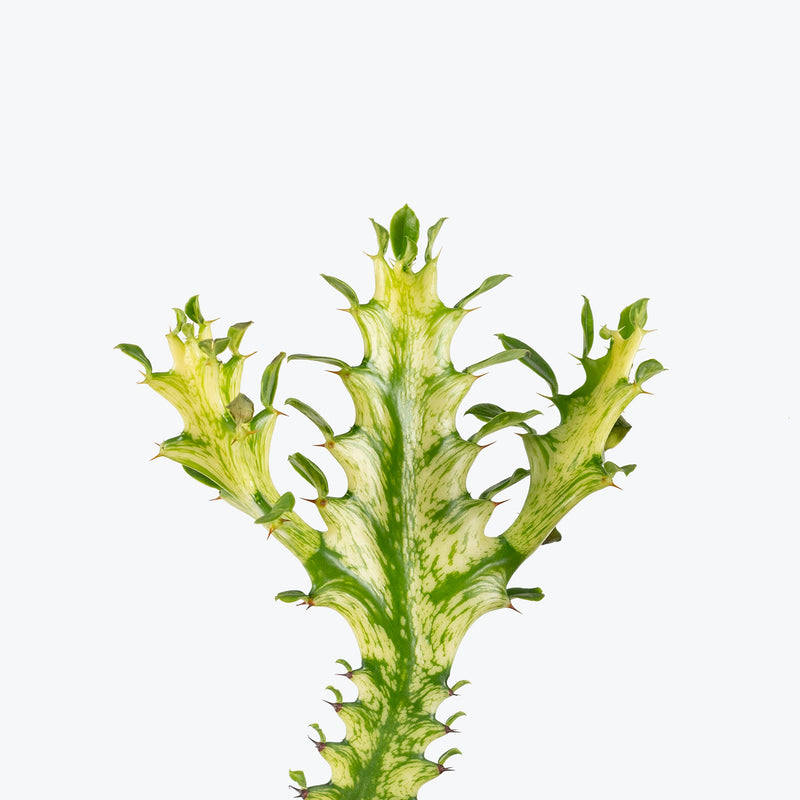
How to care for Euphorbia Mint Cream
Euphorbia Mint Cream enjoys some direct sun, but they'll also do well in bright, indirect light. It is best to place this plant somewhere where it will receive some nice morning sun, or a couple hours of afternoon sun, and then indirect light the rest of the day.
Euphorbia Mint Cream will thrive in bright light, but also can tolerate medium light. A good medium-light place in your home would be in the middle of a room that has a regular size window. They can be placed anywhere between the middle of the room and the window. Remember that plants will grow based on how much light they receive.
Euphorbia Mint Cream likes the soil to be completely dry before the next watering. That usually takes about 4 weeks in an average home environment. It will vary depending on the time of year, your environment and lighting conditions, but for them, it's always safer to underwater or water when you see signs of lack of water (i.e. wrinkly or soft leaves). Water a little more often in the warmer months.
Their humidity requirement is low, so do not mist Euphorbia Mint Cream or put them in an enclosed terrarium.
Use a well-draining soil mix formulated for cacti or succulents. Fertilize sparingly, using a balanced liquid fertilizer during the growing season, every 4-6 weeks. Be cautious with pruning; this plant's sap can be irritating to the skin and eyes. Always wear gloves and wash your hands after handling.
Euphorbia Mint Cream is moderately toxic and can cause some adverse reactions when ingested so it is best to not let your pets eat it, which we advise for all plants in general. The severity of the reaction will depend on how much of the plant is ingested but, if you know your pet typically does not eat your plants, this plant will be suitable for your home..
View PlantEuphorbia Pentagona
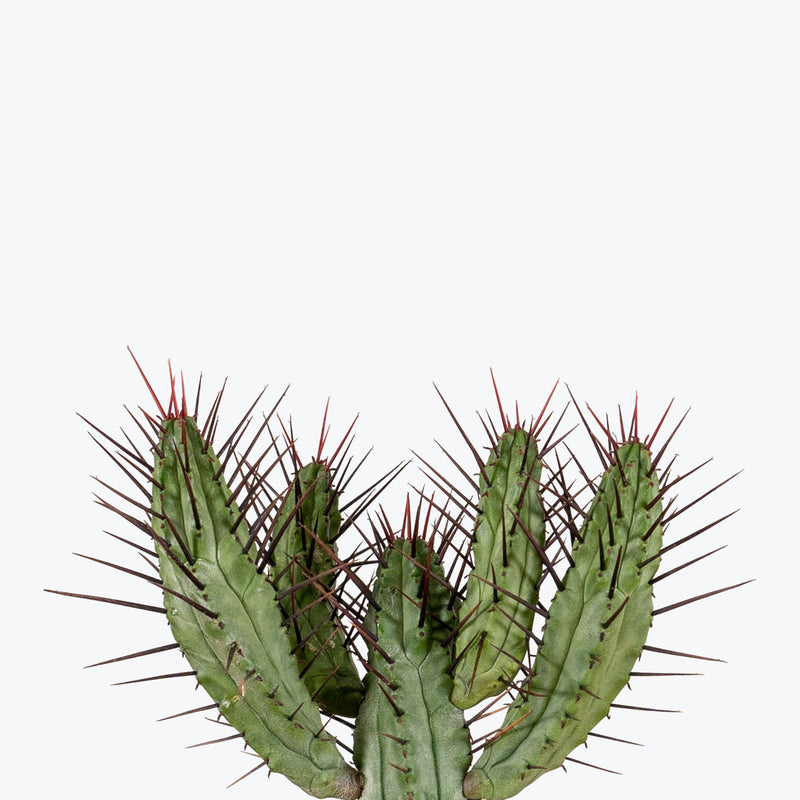
How to care for Euphorbia Pentagona
They enjoy some direct sun, but they'll also do well in bright, indirect light. It is best to place this plant somewhere where it will receive some nice morning sun, or a couple hours of afternoon sun, and then indirect light the rest of the day.
They will do best in bright light. A nice bright place inside your home would be on the window sill or a stool that is right next to a window, either with or without blinds, depending on if the plant can handle sun. Remember that plants will grow based on how much light they receive.
They like the soil to be completely dry before the next watering. This can take up to 4 weeks in an average home environment but it will vary depending on the time of year, your environment and lighting conditions. For them, it's always safer to underwater or water when you see signs of lack of water (i.e. wrinkly or soft leaves). Water a little more often in the warmer months.
Their humidity requirement is low, so do not mist them or put them in a terrarium.
They will bloom best with at least 6 hours of full light exposure every day. They can be prolific bloomers, with wonderful lavender to purplish colour flowers.
This plant is moderately toxic and can cause some adverse reactions when ingested so it is best to not let your pets eat it, which we advise for all plants in general. The severity of the reaction will depend on how much of the plant is ingested but, if you know your pet typically does not eat your plants, this plant will be suitable for your home..
View PlantEuphorbia Tithymaloides Nana
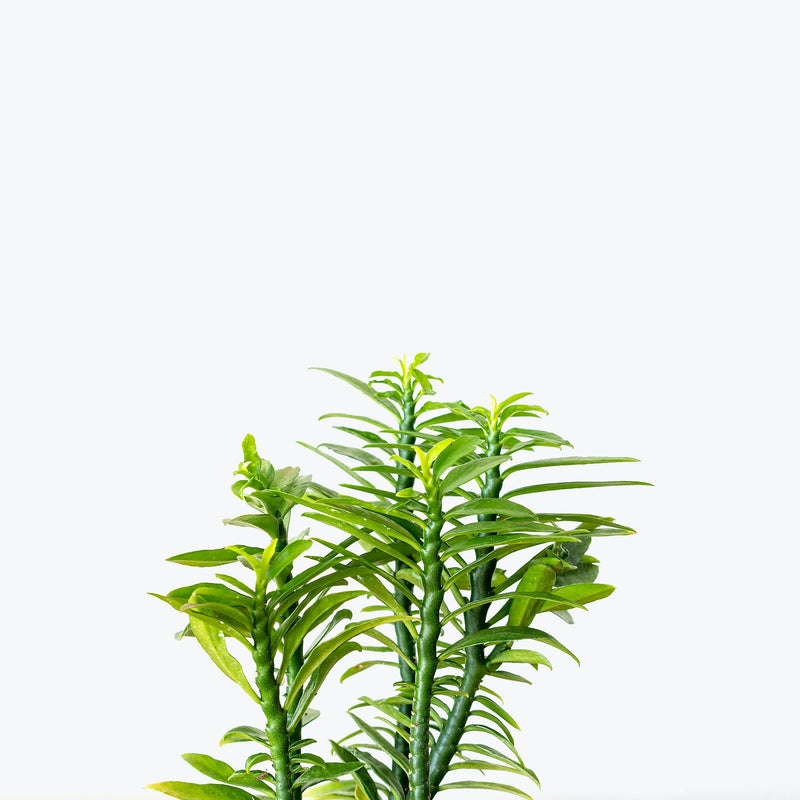
How to care for Euphorbia Tithymaloides Nana
Euphorbia Tithymaloides Nana enjoys some direct sun, but they'll also do well in bright, indirect light. It is best to place this plant somewhere where it will receive some nice morning sun, or a couple hours of afternoon sun, and then indirect light the rest of the day.
Euphorbia Tithymaloides Nana will do best in bright light. A nice bright place inside your home would be on the window sill or a stool that is right next to a window, either with or without blinds, depending on if the plant can handle sun. Remember that plants will grow based on how much light they receive.
Euphorbia Tithymaloides Nana likes the soil to be relatively dry before the next watering. That usually takes about 2 weeks in an average home environment. It will vary depending on the time of year, your environment and lighting conditions, but for them, it's always safer to underwater or water when you see signs of lack of water (i.e. droopy, floppy, or soft leaves). Water more often in the warmer months!
Their humidity requirement is low, so do not mist Euphorbia Tithymaloides Nana or put them in an enclosed terrarium.
Euphorbia Tithymaloides Nana is drought-tolerant and prefers to be under-watered, especially during the cooler months. Not sure when to water? Wrinkles on the leaves are a telltale sign. This plant can benefit from occasional pruning to maintain its shape and promote fuller growth. Handle with care, as the sap can be irritating to the skin and should not come into contact with eyes.
Euphorbia Tithymaloides Nana is moderately toxic and can cause some adverse reactions when ingested, so it is best to not let your pets eat it, which we advise for all plants in general. The severity of the reaction will depend on how much of the plant is ingested but, if you know your pet typically does not eat your plants, this plant will be suitable for your home..
View PlantEuphorbia Tithymaloides Nana Variegata

How to care for Euphorbia Tithymaloides Nana Variegata
Euphorbia Tithymaloides Nana Variegata enjoys some direct sun, but they'll also do well in bright, indirect light. It is best to place this plant somewhere where it will receive some nice morning sun, or a couple hours of afternoon sun, and then indirect light the rest of the day.
Euphorbia Tithymaloides Nana Variegata will do best in bright light. A nice bright place inside your home would be on the window sill or a stool that is right next to a window, either with or without blinds, depending on if the plant can handle sun. Remember that plants will grow based on how much light they receive.
Euphorbia Tithymaloides Nana Variegata likes the soil to be relatively dry before the next watering. That usually takes about 2 weeks in an average home environment. It will vary depending on the time of year, your environment and lighting conditions, but for them, it's always safer to underwater or water when you see signs of lack of water (i.e. droopy, floppy, or soft leaves). Water more often in the warmer months!
Their humidity requirement is low, so do not mist Euphorbia Tithymaloides Nana Variegata or put them in an enclosed terrarium.
Euphorbia Tithymaloides Nana Variegata is drought-tolerant and prefers to be under-watered, especially during the cooler months. Not sure when to water? Wrinkles on the leaves are a telltale sign. Be cautious when handling this plant, as the sap can be irritating to the skin and eyes. Wear gloves when pruning or repotting to avoid contact with the sap.
Euphorbia Tithymaloides Nana Variegata is moderately toxic and can cause some adverse reactions when ingested, so it is best to not let your pets eat it, which we advise for all plants in general. The severity of the reaction will depend on how much of the plant is ingested but, if you know your pet typically does not eat your plants, this plant will be suitable for your home..
View PlantEuphorbia Trigona
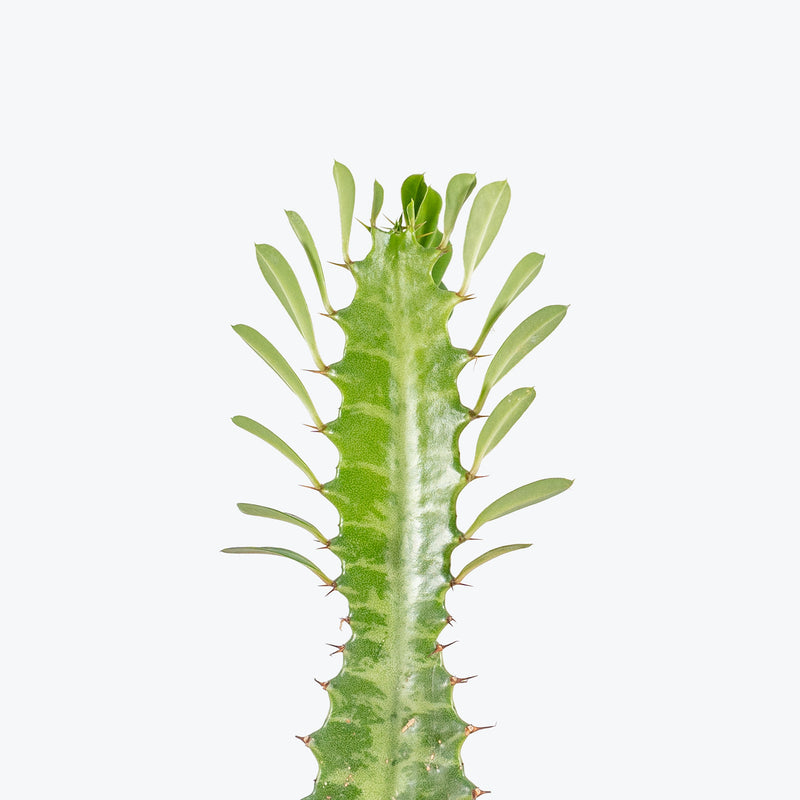
How to care for Euphorbia Trigona
Euphorbia Trigona enjoys some direct sun, but they'll also do well in bright, indirect light. It is best to place this plant somewhere where it will receive some nice morning sun, or a couple hours of afternoon sun, and then indirect light the rest of the day.
Euphorbia Trigona will thrive in bright light, but also can tolerate medium light. A good medium-light place in your home would be in the middle of a room that has a regular size window. They can be placed anywhere between the middle of the room and the window. Remember that plants will grow based on how much light they receive.
Euphorbia Trigona likes the soil to be completely dry before the next watering. That usually takes about 4 weeks in an average home environment. It will vary depending on the time of year, your environment and lighting conditions, but for them, it's always safer to underwater or water when you see signs of lack of water (i.e. wrinkly or soft leaves). Water a little more often in the warmer months.
Their humidity requirement is low, so do not mist Euphorbia Trigona or put them in an enclosed terrarium.
Euphorbia Trigona are drought-tolerant and prefer to be under-watered, especially during the cooler months. Not sure when to water? Wrinkles on the leaves are a telltale sign. Keep them in a very warm location a well. Handle with care, as the sap can be irritating to the skin and is toxic if ingested.
Euphorbia Trigona is moderately toxic and can cause some adverse reactions when ingested so it is best to not let your pets eat it, which we advise for all plants in general. The severity of the reaction will depend on how much of the plant is ingested but, if you know your pet typically does not eat your plants, this plant will be suitable for your home..
View PlantEuphorbia Trigona Rubra

How to care for Euphorbia Trigona Rubra
Euphorbia Trigona Rubra enjoys some direct sun, but they'll also do well in bright, indirect light. It is best to place this plant somewhere where it will receive some nice morning sun, or a couple hours of afternoon sun, and then indirect light the rest of the day.
Euphorbia Trigona Rubra will thrive in bright light, but also can tolerate medium light. A good medium-light place in your home would be in the middle of a room that has a regular size window. They can be placed anywhere between the middle of the room and the window. Remember that plants will grow based on how much light they receive.
Euphorbia Trigona Rubra likes the soil to be completely dry before the next watering. That usually takes about 4 weeks in an average home environment. It will vary depending on the time of year, your environment and lighting conditions, but for them, it's always safer to under water or water when you see signs of lack of water (i.e. wrinkly or soft leaves). Water a little more often in the warmer months.
Their humidity requirement is low, so do not mist Euphorbia Trigona Rubra or put them in an enclosed terrarium.
Euphorbia Trigona Rubra are drought-tolerant and prefer to be under-watered, especially during the cooler months. Not sure when to water? Wrinkles on the leaves are a telltale sign. Keep them in a very warm location a well. Handle with care, as the sap can be irritating to the skin and is toxic if ingested.
Euphorbia Trigona Rubra is moderately toxic and can cause some adverse reactions when ingested so it is best to not let your pets eat it, which we advise for all plants in general. The severity of the reaction will depend on how much of the plant is ingested but, if you know your pet typically does not eat your plants, this plant will be suitable for your home..
View PlantEyelash Fern

How to care for Eyelash Fern
They should not be in a position to see the sun directly, although early morning or late evening sun is fine. Filtered sunlight through a sheer curtain is best and most homes are comprised primarily of indirect sunlight. The best spot for them is where they do not see the sun during the majority of the day but still get bright, indirect light.
They will do best in bright light. A nice bright place inside your home would be on the window sill or a stool that is right next to a window, either with or without blinds, depending on if the plant can handle sun. Remember that plants will grow based on how much light they receive.
They like the soil to stay consistently moist, but not soaking wet. Give them water whenever just the surface of the soil is starting to get dry.
They like a high humidity environment, give them a mist daily or as often as possible. Alternatively, you can put them around a humidifier. Although they won't die if they don't receive enough humidity, their leaves may have some dry, crunchy, or yellow edges.
Too much direct sunlight will cause the tips to brown, but it definitely loves a lot of bright, indirect light. Be patient with ferns, as they are known to be very finicky. Allow it to get used to your home and keep the soil moist at all times.
This plant is moderately toxic and can cause some adverse reactions when ingested so it is best to not let your pets eat it, which we advise for all plants in general. The severity of the reaction will depend on how much of the plant is ingested but, if you know your pet typically does not eat your plants, this plant will be suitable for your home..
View Plant



